
| Here are some photo's of Wayne Harrison & Sacha Bowling filming with students: |
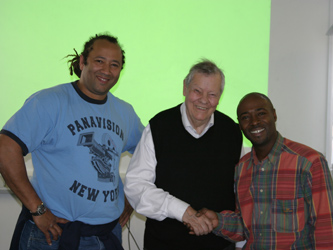 |
Wayne Harrison and Sacha Bowling are being congratulated by Anthony Hoskyns (CEO) for their hard work on another successful Video Production Course, (Notting Dale Technology Centre, Room 1). Summer 2007. |
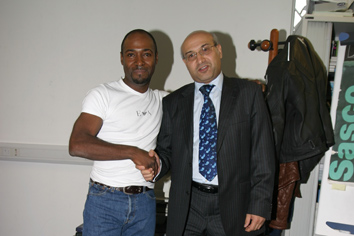 |
Wayne Harrison is being congratulated by Hoss Malek (Managing Director) for his hard work on another successful Video Production Course, (Notting Dale Technology Centre, Room 1), Summer 2005 |
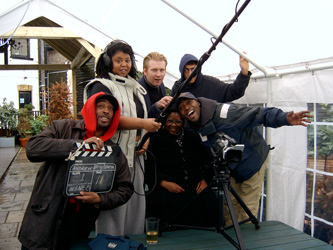 |
Wayne Harrison has taken timeout to pose with some members of the "Roses Are Red" film crew. (Station House Pub Garden), Winter 2007 |
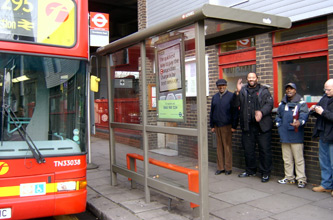 |
Wayne Harrison and Sacha Bowling are with the "No Smoke Without Fire" team on a location survey (Technical Recce). They are working out which bus stop will work for the students project. A thorough location recce is the best starting point because it's only when you've seen what you intend to shoot that you can work out how to shoot it! You'll forget the details by the time you get home, so make copious notes, take photographs to remind you and draw some sketches to show proposed camera positions. (Bramley Road), Winter 2006 |
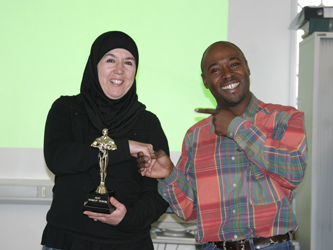 |
Wayne Harrison is congratulating Beverley Shirazian who has just won the award, best make-up design for her movie called "Reflections". Beverley had to make a lot of sacrifices and ask many favours from family and friends i.e. Samantha Cox who was the make-up artist in order to make her movie the success it was. She worked very hard as a part of the team and was fully committed to making her movie and also the other project called "Roses are Red", where she was the art director. Notting Dale Video Productions would just like to thank Beverley Shirazian for her contribution in helping us make two fantastic movies. (Notting Dale Technology Centre, Room 1), Winter 2007 |
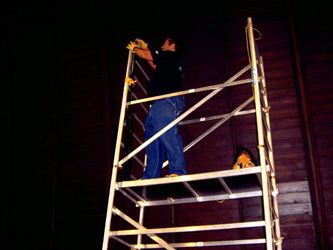 |
Sacha Bowling is building the scaffolding tower so that he can put a blonde 2k / tungsten studio light and a camcorder safely on top to get some impressive high shots for a movie called "A Midsummer Nightmare". Light controls every aspect of what we do. The main advantages of sunlight over artificial light are that it is free, covers your entire scene and is quite easy to manipulate. The problem with sunlight is that it changes colour throughout the day. This is generally something that you can't see with the human eye unless it's sunset or sunrise. Light is the essence of the scene. It creates the mood and atmosphere of the environment and helps to develop the character of the actor. A well-lit scene is often a combination of direct, diffused and bounced light source. Take away the light and all you've got is a radio show. (Harrow Club Sports Hall), Autumn 2006 |
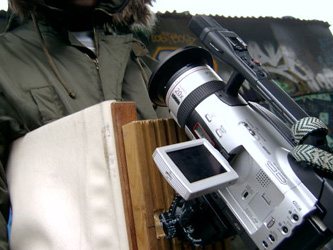 |
Anthony Lewis is waiting for Sacha Bowling to rig the camcorder onto his body for a movie called "The Sweeper". This is because when he beats up the tramp, it will give the impression of the tramps point of view without risking the camcorder accidentally falling on the ground. POV shots also include shots from extreme vantage points, such as from directly overhead (bird's-eye view) or so the actors can look and talk into the camcorder to give the impression of someone's point of view (POV), which is the angle from which the viewer sees an object. (Westway), Summer 2007 |
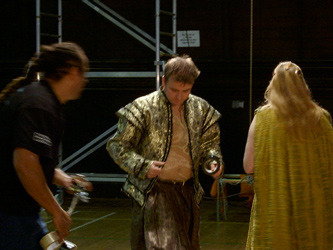 |
Helen Oakleigh and Richard Stride are the main stars on a movie called "A Midsummer Nightmare" and are working out where their mark should be with the help of Sacha Bowling. Helen Oakleigh has kindly supplied the wardrobe which looks very impressive. Minimise the amount of times a character changes clothes and remember that you may need clothes for re-shoots so keep hold of them after the wrap. Some sequences, especially stunts or scenes with water or rain, may need stand-by clothes for a 2nd or 3rd take. Ensure these scenes use cheap clothing so as not to double up on expensive items that may not get used. (Harrow Club Sports Hall), Autumn 2006 |
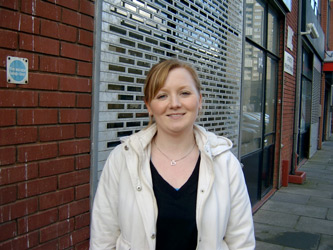 |
Samantha Cox is a professional make-up artist and she has done a brilliant job on a movie called "Reflections". Notting Dale Video Production would recommend her highly for doing make-up on a small or large film production! (Freston Road), Winter 2007 |
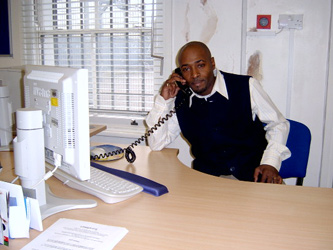 |
Wayne Harrison is blocking out the action for one of his students who is doing a creative recce and is checking out different locations for their film. Think creatively, many locations can double for several different parts of your story. This will minimise the time you waste moving between places. Getting to and from difficult locations can be very costly in terms of time. One hour traveling is one hour less shooting. Don't underestimate the chaos of moving thirty cast and crew just one mile down the road. Try and reuse sets. Once one room has been shot in, could it be repainted and dressed to be another location altogether? (Notting Dale Technology Centre, Admin Room), Winter 2007 |
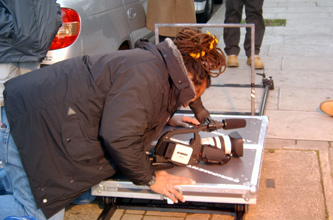 |
Sacha Bowling is doing a little bit of camera operating on his movie that he has written, produced, directed and edited which is called "TERRORIST". At one time almost all films were produced in studios which provided all the facilities and the equipment. Studios were used almost continuously and most economically. But once it became cheaper to travel to locations, rather than construct sets, different demands for equipment resulted. For the producer continuously engaged in production, owning his own camcorder, lighting and editing equipment offers convenience and is probably a necessity. However, the very high cost of buying film equipments (which may be used insufficiently to produce an economic financial return on the capital outlay) has led to specialist firms providing a complete hire service. (Freston Road), Winter 2006 |
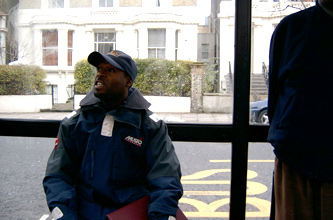 |
Wayne Harrison is explaining to the "No Smoke Without Fire" team why the bus stop they have chosen won't work for their short movie. This is because of the little room they have available for shooting and also more important, you don't want to disturb the public from walking on the pavement by blocking up the road with a lot of people making a film. The only option is to keep looking and choose a different location that is big enough for your crew, equipment and the action to happen without any problems. (Cambridge Gardens), Winter 2006 |
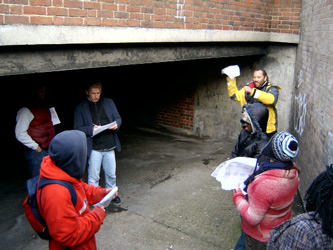 |
Sacha Bowling is helping Beverley Shirazian who is the script writer and producer, explain to the crew how she visualises in her mind the scene to be acted out. This is so everybody is clear about what should happen on the day of filming. When filming begins copies of the storyboard are given to the crew so that everyone knows what is required for each shot in the way of placement of lights, camera movement, movement of actors etc. You should also issue a movement order to all your crew and staff. This is a piece of paper with photocopied map (the route picked out with highlighter pen), explicit directions and mobile phone numbers for those who get lost. (Shalfleet Drive Garage), Winter 2007 |
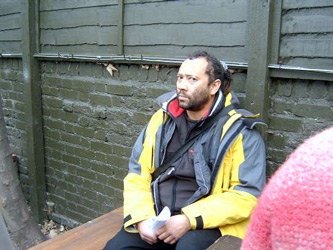 |
Sacha Bowling is doing his Lenny Henry impression on a technical recce with the Roses Are Red film crew. (Station House Pub Garden), Winter 2007 |
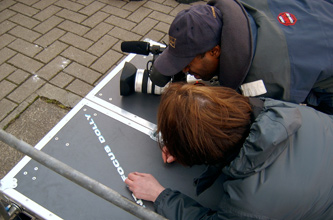 |
Wayne Harrison is checking the aperture and framing on the Canon XL2 before Shaunagh Muir starts recording. The aperture controls the amount of light allowed to pass through a lens. It is regulated by the iris, which looks and operates similarly to the iris in our own eyes. When shooting in low-light situations the iris opens up to allow more light to fall onto the CCD's. The amount of opening of the iris is expressed as an f stop, which is a mathematical equivalent calculated by dividing the focal length by the effective diameter of the lens that is in use at that particular setting. The Light meter is a built-in device that the point-and-shoot uses to measure light and determine the correct exposure setting. This is useful for finding out how bright or dark an area is, so if needed you can add more light or take away light. (Freston Road), Winter 2006 |
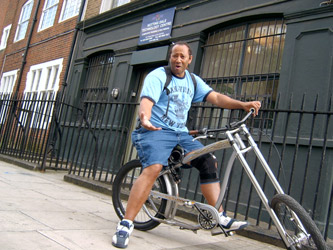 |
Sacha Bowling has just finished making a short film called "Deceit" with his students and is getting ready to go home on his stylish Los Angles bike. Don't think that when you wrap that is the end of the shoot. Keep shooting new scenes and cutaways as you need them. (Freston Road), Summer 2006 |
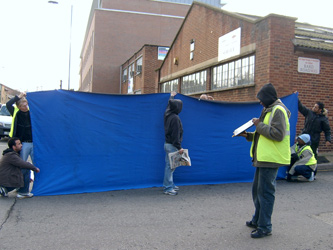 |
The Notting Dale film crew have a crazy idea which is to try and hold the blue screen in the middle of the road for an effects shot. It never worked because more planning was needed! Closing down streets in the UK is difficult. The police will be as helpful as they can, but they have crimes to stop and don't relish the thought of holding the hand of a crawling producer. (Bard Road), Winter 2007 |
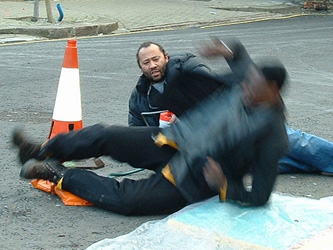 |
Sacha Bowling is giving Patrick Quarshie instructions on when to dive onto the crash mat. It is important for the department's staff to stay relaxed and unruffled under extreme pressure, whether that comes from an anxious artist or from a floor assistant demanding the artist be ready in two minutes! These particular departments are also expected to create a calm and relaxing environment for the artists and members of the public appearing on camera. They are the last ports of call before the individuals give a performance or interview, and there will be considerable anxiety. (Freston Road), Spring 2004 |
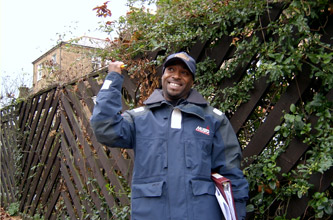 |
Wayne Harrison is blocking out the action with the "No Smoke Without Fire" team to figure out where the terrorist should be standing before he pretends to stab a man in the leg. Sometimes we may have to accept something that could have been more successful for us personally but is, in all other respects, successful for others. (Maxilla Walk), Winter 2006 |
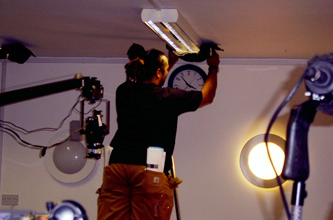 |
Sacha Bowling is putting black wrap over certain sections of the fluorescent lights to create a pool of light in particular areas of the room to set the tone of a moody atmosphere for his movie called "TERRORIST". When you adjust the relative intensities of lamps to achieve a particular pictorial effect, you are controlling the lighting balance. You may simply be aiming at pleasing tonal relationships in the picture. Or you may be adjusting intensities to develop a certain mood, suggest an environment, or to direct the audience's attention to selected areas. (Notting Dale Technology Centre, Admin Room), Winter 2006 |
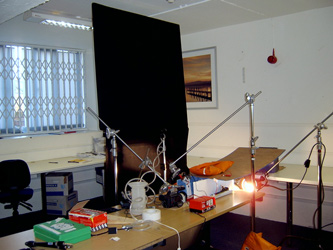 |
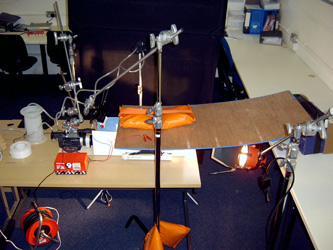 |
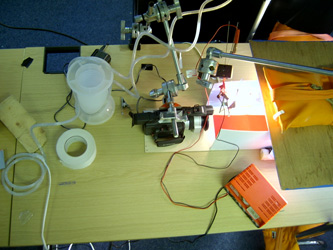 |
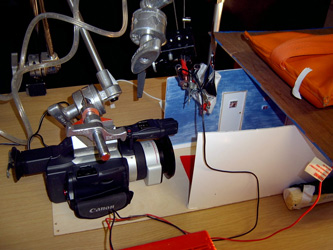 |
Film models have to be made to extremely high standards as the camcorder can quickly detect any faults. Models are frequently combined with live action and sound effects added in dubbing build up the illusion. The camcorder is usually run faster than normal, so that on projection, movements are slower and more realistic. (Notting Dale Technology Centre, Basement Office), Winter 2007 |
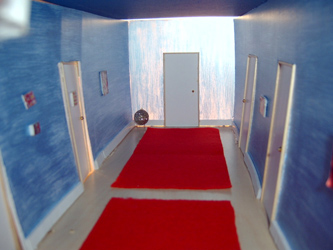 |
Beverley Shirazian had to build a quarter size model of an empty corridor for an explosion scene at the beginning of her movie called "Reflections". With the help from her friend Malikia Moses they did a very good job to build this model within a day. (Notting Dale Technology Centre, Basement Office), Winter 2007 |
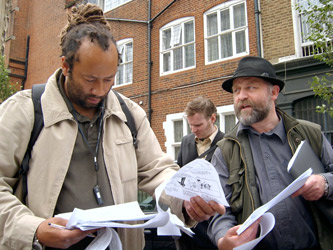 |
Guy Carter is the script writer and producer on his film called "The Sweeper" and he is checking the storyboard's with Sacha Bowling who is the assistant director. Storyboard's help you, and your cast and crew, visualise the whole movie. Stick man storyboard's are perfectly adequate, they are simply a means of conveying shots and spatial positioning. Use overhead camera diagrams to show where the camera and actors will move during a scene, this will speed everything up on the day. In the absence of storyboard's at least have a detailed shot list for your first assistant director. (Freston Road ), Summer 2007 |
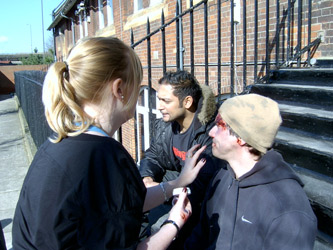 |
Samantha Cox is in full swing as she puts fake blood onto Christian Moore's face to give the impression that he has been seriously injured for a knockdown scene. This is used to create physical characteristics which an actor does not possess. The professional expertise of the make-up artist, can apply them so convincingly that they are not detected by the camcorder. The effect must also be capable of precise re-creation for each day's shooting. Where slightly different make-ups are required for a gradual ageing process (not necessarily shot in logical sequence), these must all be preplanned and are generally screen-tested before shooting. When the main objective is to reproduce skin tones as naturally as possible, for women nowadays almost any everyday make-up with a natural look is acceptable for filming. (Bard Road), Winter 2007 |
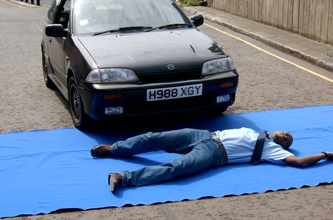 |
Wayne Harrison is lying down on top of a blue screen sheet because special effects will be required for the end scene of a movie called "The Call". He will get up after 30 seconds and take away the blue screen sheet so that the road, which will act as a background plate can also be recorded for 30 seconds. In order for this effect to work the camcorder must be locked off, which means that the camcorder must remain in the exact same position for both shots so that they match perfectly when it is time for editing and putting them together in post-production. (Bard Road), Summer 2005 |
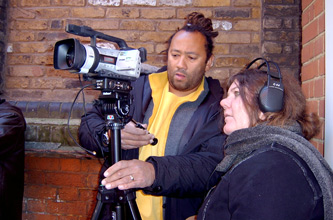 |
Sacha Bowling is showing Deborah Hall where he wants her to position the camcorder. Deborah wants to become a camera operator but as with any craft, to become a master requires years of experience and exposure to many different situations! Unlike TV which uses up to five camcorders at the shooting stage, filming usually calls for only one camcorder. The most common exceptions to this are unrepeatable events, such as processions, pop concerts or items destined to be destroyed by explosion or fire, which are uneconomic to rebuild. (Harrow Club), Winter 2006 |
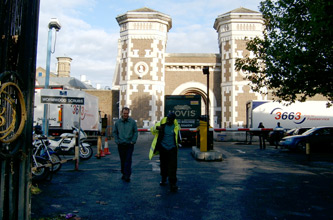 |
Wayne Harrison is the director and is showing Martin Spear who is the main actor how he wants him to walk out off the prison yard, on a movie called "Tirisano Diamond's". People get a little over half of their information about the world around them from their eyes. A classic study done revealed that people's influence is 55% visual (what we see), 38% vocal (the content of what we hear), and 7% verbal (how things are said). (Wormwood Scrubs Prison), Winter 2004 |
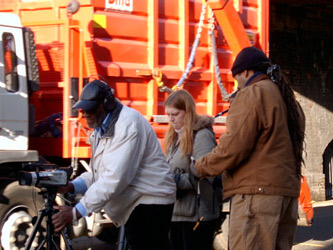 |
Michael Barnes and Helen Oakleigh are the camera operators under the supervision of Sacha Bowling on a movie called "Happy Days".Shooting on tape formats such as DV often means that the directors will say 'leave it running whilst I just..'. This can mean hours and hours of wasted footage that doesn't cost much in terms of tape, but will cost you severely in the cutting room in wasted time and frustration. Whatever the format, remain disciplined about shooting absolutely no more than is needed. (Bramley Road), Autumn 2006 |
 |
Sacha Bowling has the Steadicam Junior, ready for action on a movie called "Tenmen Fly's To Earth". When the camcorder moves through space, the viewer experiences the most distinctly cinematic of the motion picture shots. The moving camcorder is perhaps the most difficult and often the most expensive shot in the cinematographer's vocabulary. These shots are called dolly, track or truck shots. The handheld camera was first experimented with during the era of Silent Cinema, especially in the films of Dreyer, Clair, Vigo and Vertov. (Harrow Club Changing Room), Winter 2004 |
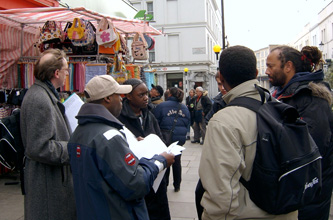 |
Sacha Bowling and Wayne Harrison are with the "Coffee" team doing a location survey (Recce). They are working out with the crew exactly how they want to film their movie. Whenever possible, locations should be scouted in advance; the British call it doing a recce (from reconnaissance). For a drama or other more controlled shoot, all the head of departments will come along to evaluate what must be built or changed. They would bring a still camera and/or camcorder to record the layout of the space. A camcorder is useful to block out shots. The location should be checked for a variety of needs: direction, lighting, sound and support. Finding a good location that suits all your needs is difficult. Often, film makers will shoot exteriors in one place, and the interior that is meant to represent the inside of that building in an entirely different place. (Portobello Road), Winter 2005 |
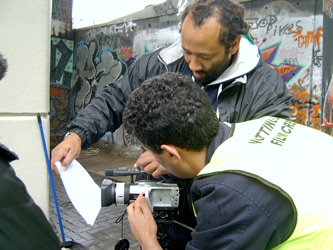 |
Sacha Bowling is showing Kamel Souiad how to set the white balance on the camcorder. White balance is the setting to use for consistent colour in studio lighting, as well as correcting fluorescent or sodium vapour lamps that tend to look green. (Westway), Summer 2007 |
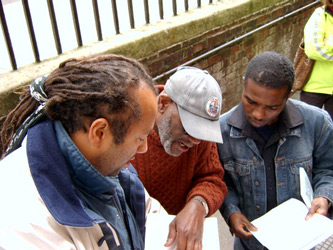 |
Michael Barnes and Markprin Jwanchin are the producer and directors. They are checking with Sacha Bowling if they will have enough time to get the shots that they need on the shooting board within the time allocated on the shooting schedule for a movie called "Happy Days". Often, directors will cling to scenes when they need to go. The final cut isn't an attempt to ruin the film, merely to make it more palatable to the audience. In general, everyone has the film's best interest at heart. Remember this and don't let things get out of hand. As a director or producer it is likely that you have less objectivity and more emotional investment in the film than anyone. Listen to other people's comments. (Notting Dale Technology Centre, Basement), Autumn 2006 |
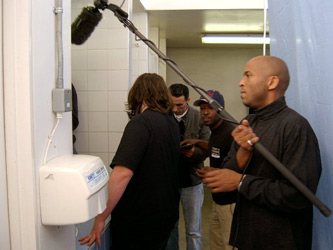 |
Wayne Harrison is making sure that Areski Boutraa has the right telephone number logged in his mobile phone so that the ring tone can be recorded for foley. Peter Nimblette is the foley artist and he is recording the ring tone of Jesse Smith's mobile phone. A good foley artist can work wonders. A foley artist is the person who adds the rustles, footsteps and any sound effects needed in the film. Sound effects (sometimes written SFX) are available from a number of sources. You can buy effects on discs and most mix facilities keep an effects library, which can be dubbed over to tape or other format for your use. (Harrow Club Changing Room), Winter 2007 |
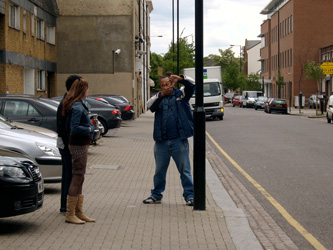 |
Sacha Bowling is the steadicam operator and is doing a rough check on what kind of framing he wants by putting his hands together to make a hole in the form of a square. This is so that he can look through it and see roughly what objects will be in the frame before Romy Bellamy-Bunn and Ivan Todorov start acting on a movie called "Deceit". The human eye can see detail in a much wider range of contrast than film emulsion. Although a person looking at a scene may see detail in every shadow and every highlight, on film anything too dark or too bright relative to the chosen exposure starts to lose definition as it approaches the extremes of the film's latitude. Details disappear into obscurity, and objects become either more bleached out or increasingly lost in blackness. (Freston Road), Summer 2006 |
 |
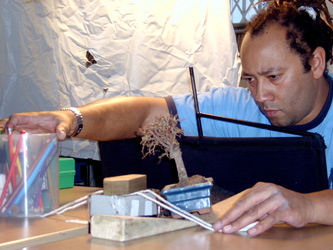 |
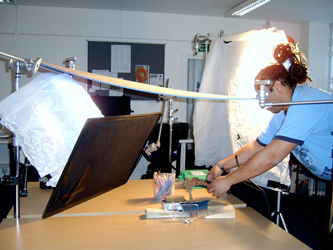 |
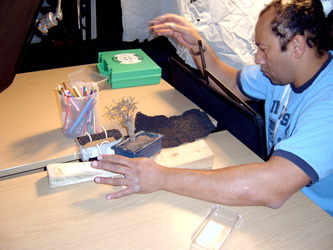 |
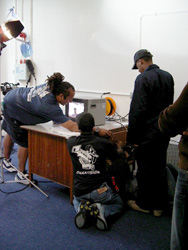 |
Sacha Bowling and Wayne Harrison are trying to sort out the broadcast monitor so that everyone can see what the camcorder is recording. The video system processes the image by dividing the picture into a series of horizontal scan lines. This pattern of lines is called the raster. The camcorder scans the image starting at the top, from left to right. It reads the brightness levels all the way across a scan line, then returns to the left side and moves down slightly as it scans across again. This is very much like the way your eye takes in a paragraph of written text. When it reaches the bottom of the screen, it returns to the top and starts over. The monitor's CRT (cathode ray tube) makes the same scanning pattern, "painting" the image on as it goes. (Notting Dale Studios), Summer 2004 |
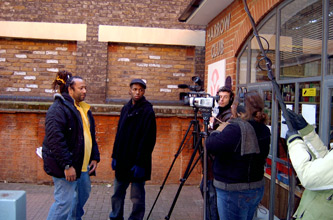 |
Sacha Bowling is explaining to the Notting Dale film crew how he wants them to act and film a scene from his movie called "TERRORIST". Always make a contract for everything, even when friends do work for you. If your movie is ultra successful, all those freebies and favours will cost you. At the same time, don't get hung up on huge wordy and over the top contracts. (Harrow Club), Winter 2006 |
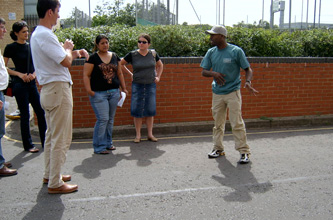 |
Wayne Harrison is on a Technical Recce with the Video Production team and is giving them some bright suggestions about what options is available to them when they film their movie. A technical recce is to work out any problems that might arise before filming begins. It is sensible to think ahead, not only for work purposes but for breaks. A film crew works better on a full stomach, especially if they are out in the cold. Tea and coffee should always be available, with someone making sure that the key personnel (who are working harder than others) have their drinks brought to them. Cover can be offered by other members of the team. (Freston Road), Summer 2005 |
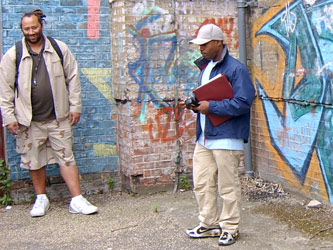 |
Wayne Harrison and Sacha Bowling are on a Technical Recce with "The Sweeper" film crew and they are checking out one of the locations to see if the chosen location fits in with the script. Every production has different needs, and therefore a wide range of knowledge and skills is required to cater for whatever is expected, and very often for what is unexpected. (Westway Basket Ball Court), Summer 2007 |
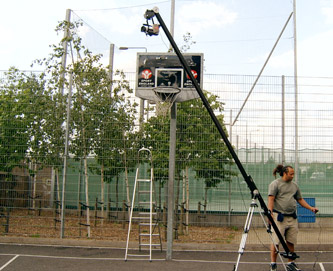 |
Sacha Bowling is testing the CamCrane which has a camcorder attached at the top. Virtually all items associated with film could be classified as specialist, as they are designed uniquely for the job whether it is shooting, editing or screening. But in addition many effects could not be achieved without additional specialist equipment which is far cheaper to hire than to buy. All reasonable safety precautions must be taken with hired equipment, but in addition insurance should be arranged both for the replacement value of the equipment and to cover re shooting costs! The larger hire companies have international connections, so that producers who wish to do so may hire their filming equipment in another country, without the need or cost of shipping it to the location. Alternatively, for remoter areas which so often seem to form the background to films, but where film equipment is not available, hire companies frequently offer freighting services. (Westway Basket Ball Court), Summer 2004 |
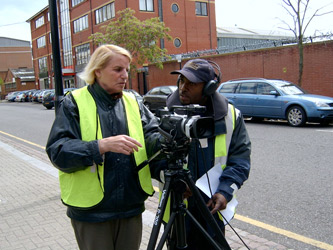 |
Helen Bangoliny is the camera operator and is checking with Wayne Harrison that she has everything properly set-up before she starts recording. It is important to maintain the continuity for sound and lighting when shooting. This is because you want the movie to look natural when people are watching it, and if there is any subtle changes in the footage the audience will notice straight away. For example this could be one minute the sound is fine then suddenly it gets very low or high. Another example could be one minute the picture looks over exposed then the next under exposed. (Freston Road), Summer 2006 |
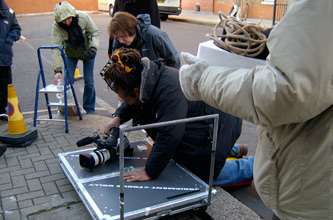 |
Sacha Bowling is telling Shaunagh Muir exactly how he wants her to operate the camcorder for a tracking shot on the dolly and track. Every job is different and requires a different mix of equipment. It's worth building up a good core kit that will tackle the basics of any shoot, but there are thousands of extra bits and pieces that you'll need only occasionally, or maybe just the once. You'd go bust trying to buy them all so do as the pros do and rent what you need when you need it. Many professional cameramen don't even own a camcorder! There are equipment rental companies in most cities and some cater for the budget end of the video industry. The range of things that you can get is enormous i.e. Lighting kits, lens filters, sound kit, waterproof camera housings, car mounts, little minicams to fit into awkward places, camera cranes, and more - it's all available for hire. (Freston Road), Winter 2006 |
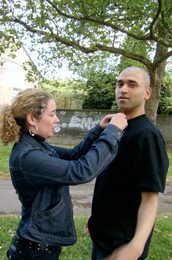 |
Jenny Grogan is attaching a radio microphone onto Aminur Rahman who is one of the main actors on a movie called "Dead End. To allow the camcorder and subject greater freedom of movement, a wireless, or radio, microphone can be used. With this system, a lavalier mic is clipped on the subject, along with a concealed radio transmitter that is about the size of a pack of cigarettes. A receiver mounted on the recorder or camcorder picks up the signal with a short antenna. Wireless sound quality is usually not as high as that of hard-wired mic's (mic's connected by cables), but some of the systems are very good. Using a wireless opens up many possibilities for both fiction and documentary shooting. You never need to compromise camera angles for good mic placement, since the mic is always close to the subject but out of view. In unscripted documentaries, there are great advantages to letting the subject move independently, without being constantly followed by a recordist wielding a long microphone. (North Pole Road), Summer 2004 |
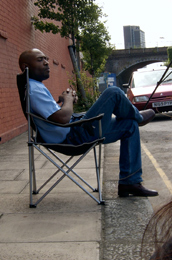 |
Wayne Harrison is relaxing on his directors chair before he goes back onto the set to start acting. Because actors are always capable of giving a performance and concealing their own identities, it is sometimes overlooked that they have feeling of their own. Not all days will be as good as others and when they feel vulnerable or insecure a director's encouragement becomes vital to their performance. (Bard Road), Summer 2005. |
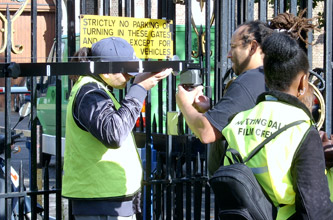 |
Sacha Bowling is setting up the CamCrane with students. (Wormwood Scrubs Prison), Winter 2004 |
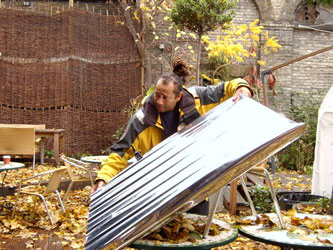 |
Sacha Bowling is the gaffer on a movie called "Happy Days" and has made a big reflector so that he can bounce the natural light source onto the subjects to fill out any shadows that might appear on the actors face. (Station House Pub Garden), Autumn 2006 |
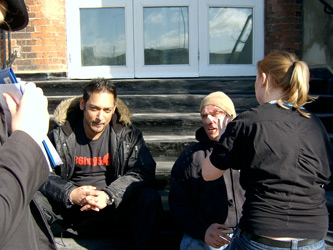 |
Christian Moore is getting make-up done by Samantha Cox. The skill of a good make-up artist is that the make-up is not seen! If someone notices it, other than for professional reasons, then it has not achieved its purpose, which is to create an illusion. Make-up time is an important period for the artist. They are about to give a performance and they will be feeling anxious. (Bard Road), Winter 2007 |
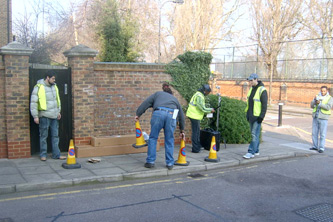 |
Sacha Bowling is putting out cones onto the pavement so nobody accidentally gets hurt or trips over equipment. Planning for safety and thinking ahead to imagine all the possible dangers is an essential step before any professional shoot, and it should be for the amateur and semi-professional as well! (Peterborough Road), Winter 2005 |
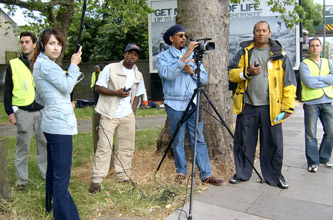 |
Sacha Bowling and Wayne Harrison are with the students, waiting for the action to begin. Production companies and designers or heads of departments like to build up a nucleus of people with whom they like to work. Networking is extremely important, not only to get to know what work is available, but to become known to those who might employ you. (North Pole Road), Summer 2004 |
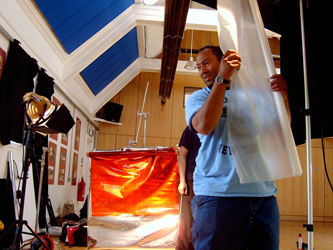 |
Sacha Bowling is putting some diffusion gel over the front of the studio lights to minimise facial lines and blemishes on the actors face. There are five basic types of diffusion, each with its own character: spun, frost, white diffusion, silk (and other fabrics), and silent diffusion. Each type is manufactured in several densities. Diffusion spreads the light, disrupts the hard parallel rays and cuts down the light's intensity. Another option could be to use a soft box or bounce the light off the wall or ceiling. One method of lighting that originated in the early days of television is to provide a fairly strong diffuse base light (foundation light), to illuminate the entire scene. (Some people use ceiling bounce light for this purpose.) All other lighting is then superimposed, each lamp being made correspondingly brighter, according to the effect required. (Harrow Club Dance Hall), Summer 2006 |
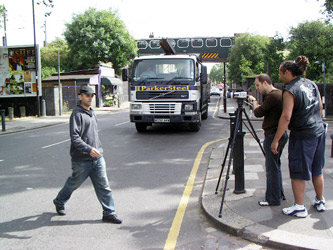 |
Sacha Bowling is helping Majid Haji Nowrouzi as he looks closely through the viewfinder and operates the camcorder on a movie called "Dead End". The viewfinder contains optics that magnify the image displayed on a small internal colour LCD screen. You should set the correct diopter for your eyesight by moving the adjustment lever until the letters displayed in the viewfinder are sharpest. (This is easier and more accurate than focusing the diopter on a distant object. (North Pole Road), Summer 2004 |
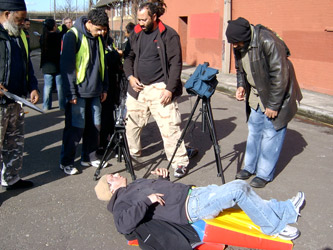 |
The Notting Dale film crew are listening to Sacha Bowling explain about crossing the line. Without a clear idea of the final product, you're likely to end up with a jumble of shots which 'cross the line', mixing motion direction so your subject appears to be moving in one direction then another. Stick to the the same 180° around your subject, from front to back. Skilled directors can manage to use 'crossing the line' to good effect, but it can be unsettling for the viewer. Probably the best way to visualise the problem is to think of how a football match is televised. All the camcorder's need to be on the same side of the pitch, otherwise one team may be playing left-to-right in one shot and right-to-left in the next. (Bard Road), Winter 2007 |
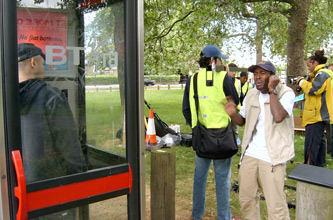 |
Wayne Harrison is telling Aminur Rahman how he wants him to act when he is on the telephone. Unlike shooting in a studio, where almost every item and situation is created artificially, location shooting offers realism. However, all too often, the situations are difficult for the film maker to control. With exterior locations, lighting is virtually dependent on the weather and nothing kills a shot more quickly than someone staring at the camcorder film lens. (North Pole Road), Summer 2004 |
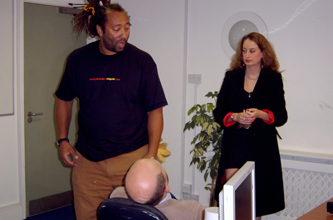 |
Sacha Bowling is directing Romy Bellamy-Bunn and is showing her how he wants the action to be in his movie called "TERRORIST". Rehearsal deals with an actor's attempts to identify the emotional truth and core of the character. This process is best not practiced too much, because it can have the unfortunate effect of flattening out the performance. In the end, you're going to want to look for performances that are truly different and compelling. Actors, properly trained, can take the words from a page in the script and breathe life into them in such a way that they seem spontaneous. The style is conversational and if an emotional appeal is required, actors can sound as though they are personally involved. (Notting Dale Technology Centre, Admin Room), Winter 2006 |
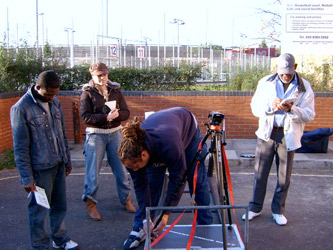 |
The Notting Dale film crew are carefully observing how Sacha Bowling is securely attaching a tripod to the dolly by using a ratchet strap, which can be very tricky! (Freston Road), Autumn 2006 |
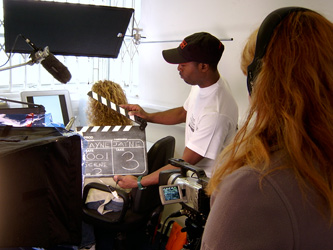 |
Wayne Harrison is doing the clapperboard on a movie called "Chain Reaction" written by Jayne Norris. Many people use an electronic timecoded clapperboard (w/external timecode generator) plugged directly into a DAT (digital audiotape) recorder. A snap of the clapperboard will then give a good visual reference on the video image so the timecode can be mated in post. A timecode clapperboard is among the digital movie maker's most essential tools. (Notting Dale Technology Centre, Room 1), Spring 2004 |
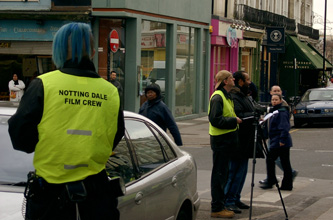 |
Sacha Bowling is giving Mark Brisenden some advice about how he should operate the camcorder and frame the next shot. On the film set, a film director will make choices about where to position the camcorder in relation to the action, that is, how to frame the shot. We can speak of camera angle, camera level, camera height and camera distance to describe some of these choices of 'framing'. The framing of the shot creates what we see on the screen. Choices about the framing of a shot change the shot's meaning. (Portobello Road), Winter 2005 |
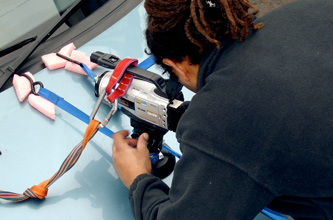 |
Sacha Bowling is rigging the camcorder to the front of the car with a safety and ratchet strap attached to it for safety purposes. (Freston Road), Winter 2004 |
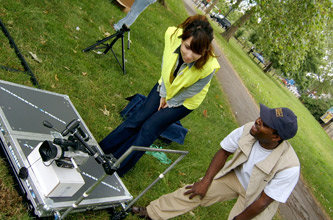 |
Wayne Harrison is giving Hala Hassan instructions on how to operate the dolly. (North Pole Road), Summer 2004 |
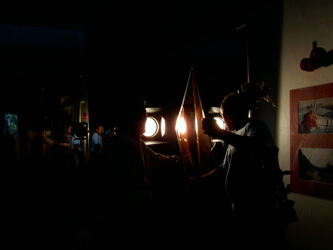 |
This photo was specially requested by Sacha Bowling. (Harrow Club Dance Hall), Summer 2006 |
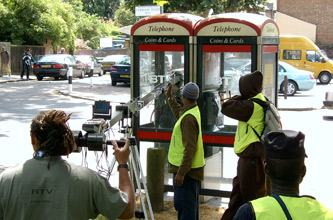 |
Sacha Bowling is on location operating the CamCrane with the help of the Notting Dale film crew. If you have no budget, shooting on location is probably the only option for you. Sometimes film crews can trash locations. Try and clean up after yourself, leave muddy boots outside, ban smoking inside etc. Remember that you may need to return back to the location so try not to upset your contacts. (North Pole Road), Summer 2004 |
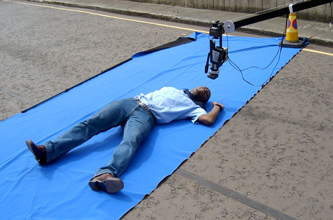 |
Wayne Harrison is doing some acting and is pretending to be lying down on the floor dead on a movie called "The Call". No one is out of reach. Make a list of people who could play the parts in your picture and approach their agents. Actors can often have a bad year and be eager for feature work, or may have a soft spot for the decadence of low budget film making. If you don't ask. you'll never know, and they may say yes! (Bard Road), Summer 2005. |
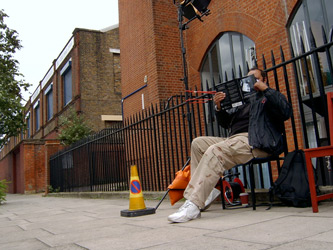 |
Sacha Bowling is relaxing before he is needed on the film set again by reading a book. There can be a lot of hanging around, particularly on location. This is usually a good time to observe how other departments works, or simply to catch up with notes and paperwork. Hours are long and often contracted into a payment deal, overtime only being paid outside of these hours. Film production units usually work a six day week, but it is not unusual to work seven days a week if problems occur. However, working in this way, so closely with others, creates an environment of it's own. You will be part of a production team under constraints, which makes for special bonding and, hopefully, it's own social life. It can be a hard, but memorable experience. (Freston Road), Winter 2007 |
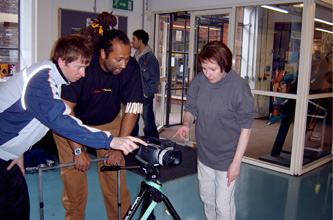 |
Sacha Bowling is telling Graham Beakhouse and Shaunagh Muir how to operate the dolly and track for an important shot that he needs for his movie called "TERRORIST". To compose a shot, study what you are going to shoot before setting up the camcorder. If you are using actors, place them on the set or use other people to stand in for them. If you have no control of the scene, study what you have. Move around and notice how the objects in the shot change in relation to each other, how they move closer or farther away, or get larger and smaller. Ask yourself how can you best relate the story visually. (Harrow Club), Winter 2006 |
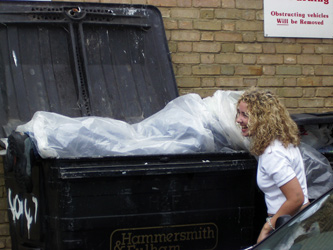 |
It's nice to see Jenny Grogan enjoying herself packing a dummy body inside the skip. Skips can be very useful, one man's rubbish is another man's treasure. A skip can be a treasure chest for the production designer with a budget that would barely buy lunch. Skips are often filled with wood, the main material needed in construction. Don't be proud, scavenge! (Caverswall Garage), Summer 2004 |
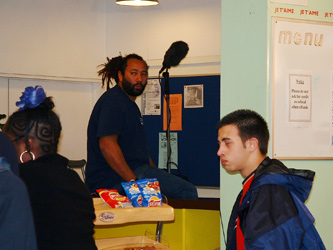 |
Sacha Bowling is the boom operator on a movie called "Just My Luck" written by Patrick Quarshie. His job is to manoeuvre the microphone as closely to the subject as possible without it getting into the shot. As a rough guide, the ideal distance between performer and microphone can be taken as about 1 metre, which would mean that most of the time during filming the microphone would be in shot. As a result a variety of microphones and methods of using them have been developed to overcome the problem. A directional microphone is hung from an extendible boom, which can be moved to follow subjects. This type of microphone is rarely static and requires skilful control by a boom operator who might be anything up to 6 metres away. While following each performer's moves, the microphone must be kept out of shot and prevented from casting unwanted shadows. (Harrow Club), Spring 2004 |
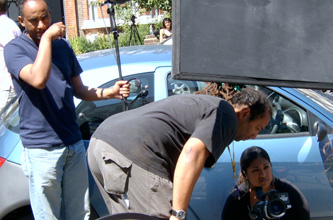 |
Sacha Bowling is checking the exposure, focus and framing on the camcorder before Sabrina Sarmiento starts recording. Film language communicates to the audience on many levels - through use of camera, lighting, editing, set design and sound - all contributing to the meaning. The relationship between shot length and motion sets the tempo of a film or scene and the two factors can be manipulated to influence audience’s perception of pace. (Chevening Road), Summer 2005 |
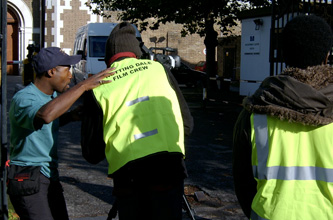 |
Wayne Harrison is checking the framing and exposure on the camcorder before Dele Awosile starts filming on a movie called "Tirisano Diamond's". Shooting in London is tough as many council have got smart and will charge you just to take a camcorder out on the streets. Be aware that parks, streets, schools, prisons and the like will probably all carry a price tag that is small to your average production, but crippling to a micro budget movie. Avoid paying at all costs! (Wormwood Scrubs Prison), Winter 2004 |
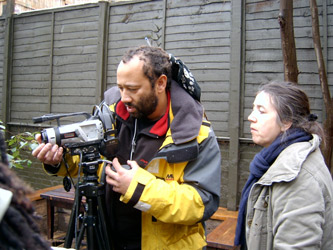 |
Beverley Shirazian is watching Sacha Bowling very carefully as he places a polarising filter onto the lens of the camcorder. Since light bounces around in all directions along it's axis, the reflections that it creates in windows, water, and glass lenses often create an impenetrable barrier. A polarising filter is an essential accessory that can reduce or eliminate these reflections. In exterior shots it can darken the sky and create far more dramatic clouds than you'd generally find. (Station House Pub Garden), Winter 2007 |
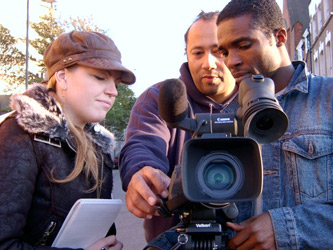 |
Markprin Jwanchin and Helen Oakleigh are watching very carefully as Sacha Bowling shows them the functions on the Canon XL2. One of the most important functions is the aperture. The amount of light reaching the film is controlled by an iris inside the lens. This aperture is adjusted by turning a ring on the lens barrel. Around the ring, indicating the aperture size, are stop numbers marked f5.6, f8 etc. Alternatively, the almost identical (but more accurate) T numbers are used, indicating the measured amount of transmitted light actually passed by the lens. Opening up the lens to a smaller number increases light reaching the film and reduces the depth of field, i.e. the range of distances before and beyond the focus point that will be rendered sharp. Stopping down to a high number has the reverse effect. (Freston Road), Autumn 2006 |
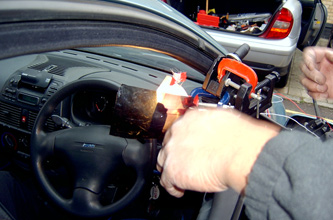 |
Sacha Bowling is putting some ND (Neutral Density) filter over the light because it is too bright on the actors face and he needs to take down the intensity a little. ND filter is a black gel, and is like putting sun glasses on the camcorder which reduces the amount of light passing through the lens without affecting the colour. You can also get Semi-Professional camcorders that have a built in ND filter that you would use on a bright sunny day when your out filming on location and your picture is looking over exposed! (Freston Road), Winter 2005 |
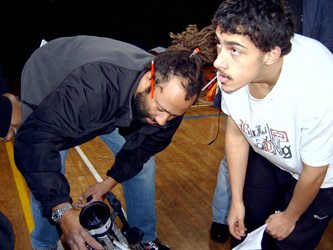 |
Alli Shelton is looking like a real film director and has requested to Sacha Bowling that he would like an extreme wide angle lens mounted on the camcorder. This is because he can show more area in the picture frame to get more of the actors in the shot. A shot should have only one subject. If a shot has more than one subject, you can break it up into two or more shots. For example, if a scene has two people conversing, you can shoot the entire scene from three different angles: one shot of both people, a second shot with the one person as the primary subject, and a third with the other person as the primary subject. (Harrow Club Sports Hall), Winter 2007 |
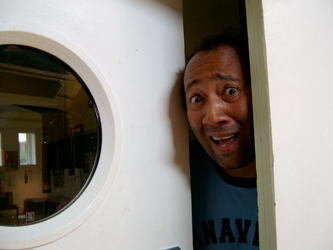 |
This is how Sacha Bowling looks in the morning before he starts to make a short film with the Notting Dale Video Production team. (Harrow Club Dance Hall), Summer 2006 |
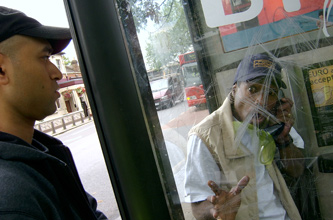 |
Wayne Harrison is directing Aminur Rahman who has never acted before. He is trying to get Aminur Rahman to give some kind of facial expression when he see's the car approaching him on a movie called "Dead End". Mapping the emotional terrain of a character is the ultimate control device generally used by egotistic directors who don't trust their actors. The director should be communicating the meaning of the line, not the inflection. Forcing actors into an attitude corner is the difference between doing something and showing something. Forced attitude creates posturing, which prevents actors from listening to each other. Nothing devalues a performance more than actors who aren't paying attention to each other. Good direction generates behaviour in the actor. (North Pole Road), Summer 2004 |
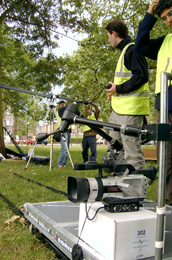 |
Sacha Bowling has rigged the camcorder to the dolly by using a magic arm. He has also put a box underneath for security reasons and also to prevent the camcorder from starting to shake around when the dolly is being pushed. (North Pole Road), Summer 2004 |
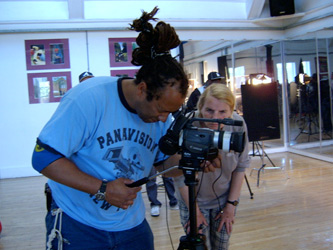 |
Helen Bangoliny is watching Sacha Bowling very carefully as he shows her how to change the aperture on the camcorder. A len’s aperture or iris is the round hole through which light from the scene enters the camcorder after being focused by the lens. A len’s maximum aperture (specified as an f-stop) indicates the size of the hole through which light enters the camera. Larger apertures (such as f/1.4) let in more light then smaller apertures (such as f/1.8) so you can take use the camcorder in dimmer light and to capture faster action (the lower an f/stop number, the larger the aperture). (Harrow Club Dance Hall), Summer 2006 |
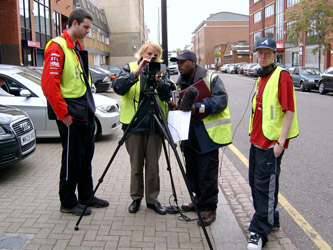 |
Helen Bangoliny is showing Wayne Harrison her framing and exposure settings before she begins filming on location. Facilities for the crew on location can be a problem. A place to eat and sit will be needed, and a film crew looks forward to only one thing and that's lunch time. It is best not to engage their wrath by providing dodgy food or too little and a loo must be provided. Feed a crew as much food as you can! (Freston Road), Summer 2006 |
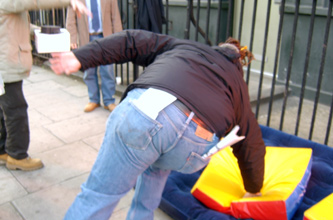 |
Sacha Bowling is testing the crash mat before one of the actors does a simple stunt and starts to jump on top of it. Actors are comforted when a stunt man is around for potentially dangerous scenes. It says to them that they are protected, that you take their safety seriously, and that you are professional. If the situation is relatively low impact and merely involves a degree of physical acting, try a trainee stuntman to lend a hand on set. For large stunts you may be required to supply a fire engine and ambulance. It's not cheap but there are dedicated film companies for this, they can charge by the hour and are usually very receptive to a plea for help on a low budget movie. Before embarking on an expensive and time consuming stunt or effect, ask yourself if you could actually cut away from it or cut out of the scene just as it is about to happen. (Freston Road), Winter 2006 |
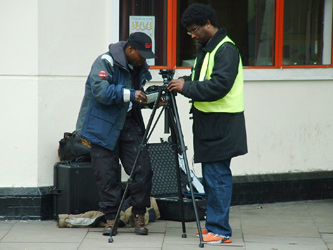 |
Wayne Harrison is helping Andre Moses set-up the camcorder by attaching the Beachtek audio base plate to the camcorder so the Sennheiser shotgun mic can be connected for good, clear sound. The best way to get good sound is to hire the best sound recordist you can. Inexperienced sound recordist's may be paranoid and request further takes when they are not needed. (Maxilla Walk), Spring 2004 |
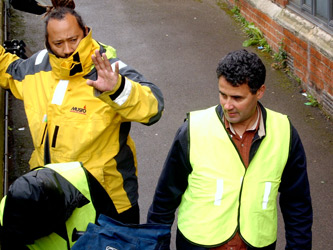 |
Sacha Bowling is the location manager and is making sure the students don't abuse the location. On a large production the first person on site will be the location manager. He or she will have planned the day's work and who needs to be where and when. Just because a piece of land or a building is accessible to the general public doesn't mean you have any right at all to shoot your movie there. You may be welcome to film the family having a day out, but different rules apply if you're shooting the movie for commercial use or for public showing. Landowners, local authorities and the police all take an interest in filming and might rightfully be able to stop you. Having said that, many people and organisations will be very welcoming, and the local police may turn up to help you with access, traffic control and so on. (Freston Road), Winter 2007 |
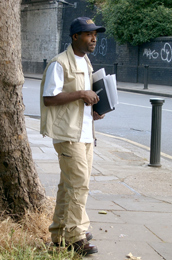 |
Wayne Harrison is in deep concentration and is thinking about how he wants to direct the action. The process of storytelling is perhaps one of the oldest professions, yet the inherent dynamics that constitute a great storyteller are often misunderstood. Don't get too anxious to call cut! Often in the cutting room, you will need that extra second on the end of a shot. When you feel the shot has ended, wait a beat before calling cut. Know in your heart if you have got what you need in your first take. Takes that are not needed waste time as well as film stock. The director must ensure that the material he or she shoots will subsequently edit together smoothly. This means ensuring that the camera angles and eyelines are correct and that the voice inflexions are right, so that in the finished film a logical conversation results. (North Pole Road), Summer 2004 |
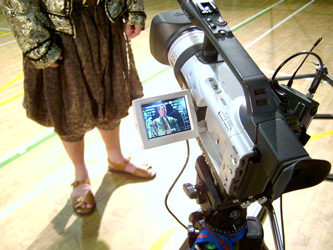 |
The Canon XM2 has a wireless receiver mounted on the right side of the camcorder which will record the dialogue from Richard Stride in his impressive wardrobe, thanks to Helen Oakleigh who was in-charge of wardrobe and make-up. He also looks good visually on the LCD monitor. The main criteria for acceptable quality of visual is to have good exposure by setting the f stop indicator to an acceptable value based on the lighting conditions at the time. Another factor is how much CCD's the camera has. Three CCD's show better quality than a camcorder that has one CCD. (Harrow Club Sports Hall), Autumn 2006 |
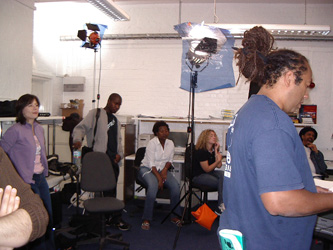 |
Sacha Bowling is the gaffer and is being watched by the students as he explains to them how to work with electrical equipment when filming at a new location. Upon arrival at each new shooting location, one of the first jobs is to establish a staging area where electrical equipment is kept, ready to go on to the set when needed. The best boy will have picked out a spot that is convenient to the set, but not so close as to block access. Stake out the spot early before all the good ones are taken. The entrance to the staging area must be clear of obstructions. You don't want a line of producers and stars sitting in chairs in front of the area. You need to be able to carry equipment in and out fast. While the director and DP are deciding on their shots, the electricians can 'head-up' a selection of lights on stands in the staging area, ready to be brought into the set when called for. Line up the lights on stands. (Notting Dale Studios), Summer 2004 |
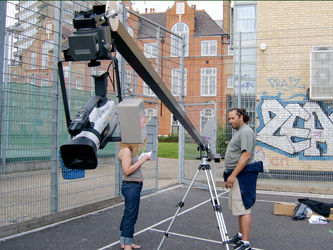 |
Sacha Bowling and Jenny Grogan are reading instructions and checking out how to use the CamCrane. (Westway Basket Ball Court), Summer 2004 |
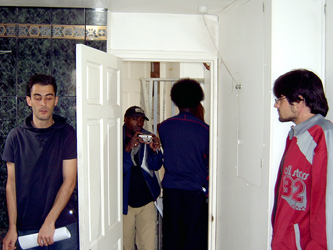 |
Wayne
Harrison has a digital camera and is taking some photo's
of the location so he can workout how he is going to light
the set. Lighting is the foundation of
all film making. Sadly, many amateurs
ignore lighting altogether, relying instead on the fact that modern camcorders
can get some sort of usable picture under almost any conditions.
This ignores the whole point of lighting, which isn't simply
to provide illumination, but to paint
the picture for you. If nothing else, it lets you control contrast to avoid the flat look of an overcast day or having burnt-out windows when shooting indoors. Strangely, even though we use our eyes all the time, a good grasp of lighting doesn't come naturally to anyone. Achieving professional results takes years of practice, but it's worth reading some books on film and video lighting to understand the theory and to learn some of the standard set-ups. The most basic of these is three-point lighting for people (a key light as the main source, a fill light to soften harsh shadows around the nose and eyes, and a backlight to catch the hair and separate the head from the background). (Anselm Road), Summer 2004 |
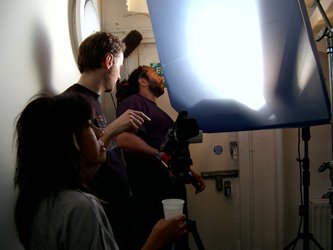 |
Sacha Bowling is showing Paul Redfearn and Parichart Daniels how to set-up a studio light in very tight space. Both on location and in the studio, you will meet situations where there is barely enough space for the camcorder, let alone any lighting equipment. Typical problem spots include elevators, tents, closets (cupboards), booths etc. The trick is to position lights so that they are not seen on the camcorder, do not get in the way, yet produce an appropriate kind of illumination! In some situations, the scene is supposed to be taking place in total darkness! Sometimes you can rig a light above the camcorder, or direct a spotlight past the camcorder, barndooring it tightly to avoid camera shadows. (Notting Dale Technology Centre), Summer 2006 |
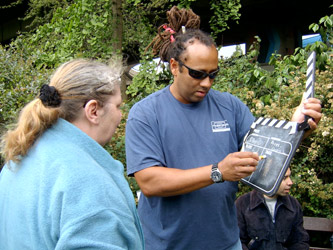 |
Sacha Bowling is helping Carol Ashby with the clapperboard. (Westway Park), Summer 2006 |
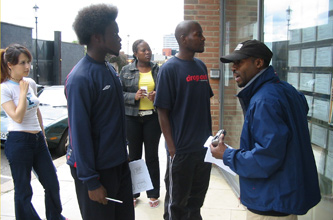 |
Benjamin Deen-Swaray has the chance to direct a few scenes from a movie called "Trapped" and is telling Wayne Harrison exactly how he wants the action to be. If you have control of your subjects, place them at their first positions. Then look for an angle where the subjects and all the other objects in the shot can be contained comfortably in the frame and each is angled the way you want. If you are using a wide angle shot, look for objects that you can place in the foreground to add a natural frame. If you're covering an event such as a wedding, you won't have much control over the action, nor can you ask for retakes. Planning becomes even more important in a case like this. No one will forgive you if you miss a crucial moment because you decided to put the camcorder where it couldn't see the action or because you were busy shooting something else! (Freston Road), Summer 2004 |
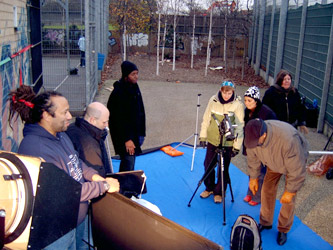 |
The Notting Dale film crew have the chance to do some filming using the blue screen for special effects. If possible, give your crew a small amount of money each day and ask them to feed themselves. This works well if you are close to shops, a canteen or cheap pub that serves meals. This way, they get a choice, you get zero catering problems. (Westway), Winter 2006 |
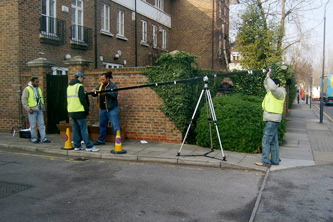 |
Sacha
Bowling is setting up the CamCrane with the help of some students. Movie
making is as much about organisation and planning
as it is about great acting or brilliant script
ideas. The starting point is setting up the shot. Set-up is an important part of production. Setting up a shot usually takes longer than the shot itself! When making feature films, a professional crew can take hours to set-up one 30 second shot. Set-up takes a long time because so many factors must be coordinated. Set-up time is directly related to the amount of work required to get everything ready to shoot. Be aware of day and night length, it can get very dark or very light alarmingly quickly. Keep an eye on the clock! (Peterborough Road), Winter 2005 |
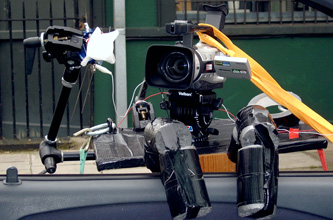 |
The Canon XM2 is all rigged up and ready for action. (Freston Road), Winter 2005 |
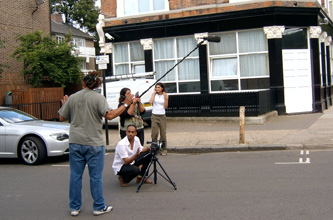 |
Sacha Bowling is making sure that no cars knock over any of the students who are filming in the middle of the road. Any work away from what is considered the production base is categorised as location work. Extra time and expense should be considered and allowed for crew traveling. Either way, extra time has to be allowed to find the location and to set-up the film equipment. In view of the extra traveling, it is likely that the working hours will be longer. Location work differs from studio work in that members of different departments are thrown together more. (Latimer Road), Summer 2005 |
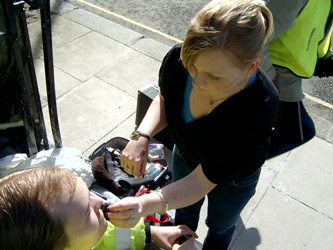 |
Samantha Cox is giving Dennis Khoroshko a little touch up on his face before he begins to start acting. Freelance staff have to provide their own materials and equipment. As they have to be prepared for every type of production and every eventuality, this means a considerable outlay. As the object of having make-up, hairstyling and wardrobe facilities is to enhance the picture quality, all productions would benefit from having them, but budget restrictions mean that very often small productions must manage without. The make-up personnel need to be very adaptable as they may be working alone or with others, and their contract may be for a day or it may be for several weeks, depending on the production. (Bard Road), Winter 2007 |
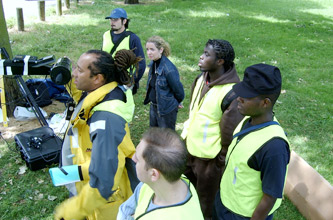 |
Sacha Bowling is showing the students how to operate the CamCrane. The television industry internationally has a vast turnover, and provides millions of people with information, education and entertainment. The viewer, however, does not see the complexities and the wide range of skills involved behind the camcorder. It is important to recognise the need in all departments for training to ensure professional and skilful work. However, with the huge expense of making programmes, budgeting is a major factor and every minute lost due to lack of knowledge and expertise costs the production money! (North Pole Road), Summer 2004 |
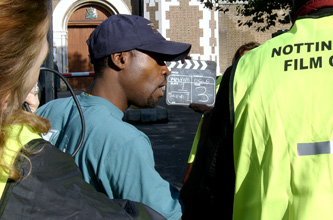 |
Wayne Harrison is the director and is telling the students how he wants the action to be on a movie called "Tirisano Diamond's". In order to tell a rich and compelling story, directors need to have experienced life from both the valleys and mountaintops. This comes with maturity. Look around at all of the truly great directors. They represent the full spectrum of the human condition and they generally have one thing in common, maturity! The best directors actually do very little directing, but rather guide with questions. What is important about this scene? Once the actor has got the attitude, then it's up to them to do the lines. (Wormwood Scrubs Prison), Winter 2004 |
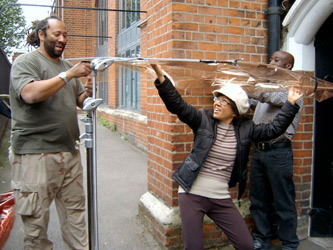 |
Parichart Daniels is having fun helping Sacha Bowling attach a gel frame onto a Century Stand. A gel frame can be used to hold light gels or diffusion for short spans of time; however, because of the heat close to the lens, many lights will melt gels mounted in the gel frame. Lighting is an area fraught with risks. Tall lighting stands can topple over, cables can trip people up, and even battery lights get hot enough to start a fire. The batteries themselves produce a harmless voltage, but they hold a great deal of charge! (Notting Dale Technology Centre, Basement), Summer 2007 |
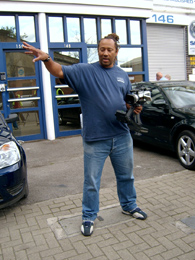 |
Sacha Bowling is operating the steadicam junior and is trying to workout what direction the actors will be walking on a movie called "Deceit". There are many potential risks involved in making a movie. Perhaps the greatest is the sense of dislocation you get with one eye shut and a camcorder glued to the other. People have been seriously injured, even killed, by stepping off a high place, tripping into machinery or walking into traffic while concentrating only on the tiny rectangle of the viewfinder or LCD monitor. Keep your senses alert and use your other eye as much as possible. If you need to move about with the camcorder, take along a companion who can keep a firm grip on you to steer you out of danger! (Freston Road), Summer 2006 |
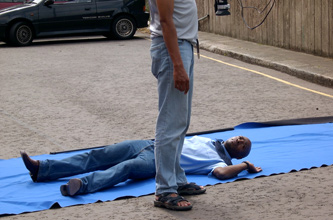 |
Wayne Harrison is doing some acting and is getting instructions from Pablo G who is one of the directors on a movie called "The Call" about how he want's him to lye down on the floor. Actors cost money. Even if they offer to work for free they will at some point probably ask for money for train fares etc. It is almost essential that your principal cast are pros, but if push comes to shove, friends and relatives are an option. Wherever possible, hire the best person you can. Try and pay everyone, if only a little. People work better with cash in their pockets. (Bard Road), Summer 2005 |
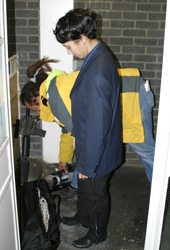 |
Sacha Bowling is positioning the camcorder low on the ground to get a dramatic shot of Kimberly Robinson taking the rope out of the bag. Framing with the LCD monitor allows much smoother handheld shots, because you are not transmitting any body movement to the camcorder, and your arms are working almost like a Steadicam. (Frinstead House Tower Block, Freston Road), Spring 2004 |
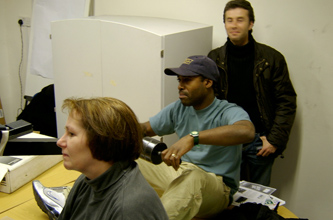 |
Wayne Harrison is in-charge of operating the CamCrane on a movie called "TERRORIST". In the world of production, we use dollies, remote-control heads, cranes and all kinds of other paraphernalia to gracefully move the camcorder during a shot. (Notting Dale Technology Centre, Admin Room), Winter 2006 |
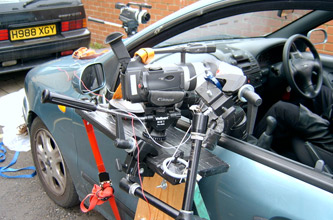 |
Sacha Bowling has designed an incredible rigging device for the camcorder to be mounted onto the side of any car. The camcorder is mounted onto a tripod head which is attached to two planks of wood, one horizontal to support the tripod head with the camcorder, and the other one is vertical to rest onto the side of the car with rubber pads so you don't scratch the car and to support the horizontal plank of wood and make it stable. A 12 volt light has been attached which is being powered by the car engine and is being held up with a magic arm. (Freston Road), Winter 2005 |
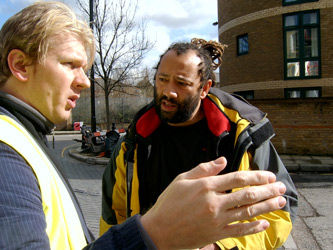 |
Terence Glover is directing a few scenes for a movie called "Reflections" and he is explaining to Sacha Bowling who is the assistant director, how he wants the action to be performed. Storyboard's will often help, but it is likely that too many shots will be boarded and that when it comes to shooting, the shots will not be possible due to the location being different, or a script re-write. (Bramley Road), Winter 2007 |
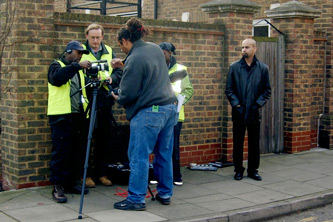 |
Sacha Bowling and Wayne Harrison have a problem with the sound on one of the camcorders and are trying to figure it out. (Peterborough Road), Winter 2005 |
 |
Wayne Harrison has been persuaded by the "Deceit" film crew to pose for the camera as he is usually the one taking all the photo's. Try to take at least 30 good shots, not of the crew working but of the main actors as they perform in front of the camera. You can never have enough stills to promote your film. (Freston Road), Summer 2006 |
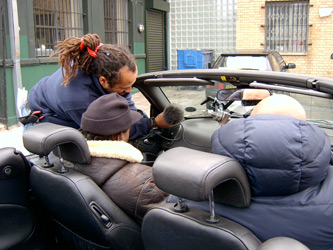 |
Sacha Bowling is rigging the boom microphone to the dashboard of the car. (Freston Road), Spring 2004 |
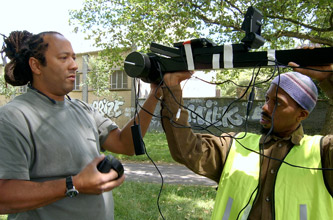 |
Sacha Bowling is showing student Neil Patterson how to put weights onto the back of the CamCrane. (North Pole Road), Summer 2004 |
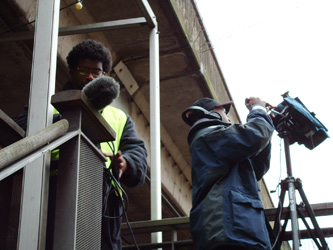 |
Wayne Harrison is on the camcorder and Andre Moses is the Sound Operator on top of the stairs at the Ion Bar. Always try and get permission to shoot wherever you intend to be. Sometimes, if you can foresee problems, it is best to simply dash in, shoot, and get out as quick as possible. (Ion Bar, Ladbroke Grove), Spring 2004 |
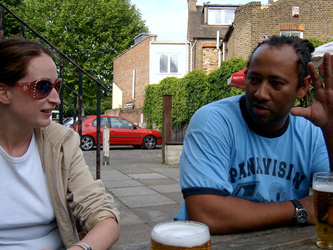 |
Sacha Bowling has just finished a hard days work making a film called "Deceit" with his cousin Romy Bellamy-Bunn who is one of the stars in the film. They are having a well deserved after work drink to reflect on how the performance has gone and how the day has progressed. (Pavilion Car Park), Summer 2006 |
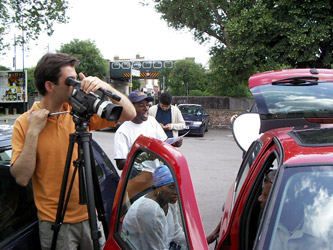 |
Wayne Harrison is reading out the script to Claude Johnson who is one of the main actors sitting in the car. Once on set, a director might decide to change his/her ideas from those on the storyboard. That is appropriate if the storyboard is only being used as a guideline for shooting. (Pavilion Car Park), Summer 2004 |
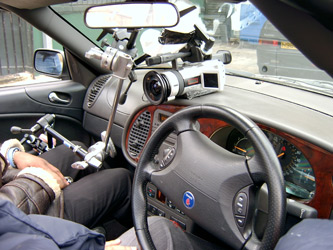 |
The camcorder has been securely mounted onto the dashboard of the car by using two magic arms, two knuckles and one arm from a century stand. (Freston Road), Spring 2004 |
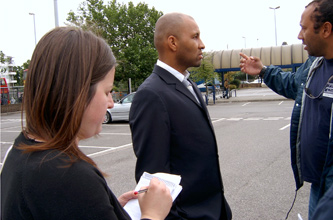 |
Sacha Bowling is giving Pablo G specific instructions about what he must do when he gets onto the bus for a movie called "Final Cut". Svjetlana Jorgic is the Script Supervisor who is responsible for continuity and making sure that all the shots match in everything from weather to hairdo. On smaller film productions any still camera which can take an instant colour picture of a scene is a useful adjunct to making notes. When continuity is particularly complex, as in a feature film, it is the responsibility of one person, the continuity girl, who lists takes and continuity detail for each scene. Shooting outdoors can be a problem as there is no way to control the weather. An exterior shot showing someone arriving at a house, followed by an interior of a house with the same person entering, although joined in the finished film by a simple cut, may actually have been separated by several months of filming. During this time people's appearances alter. For instance, hair grows. Memory can play tricks and written notes are essential. (Sainsbury's Car Park), Summer 2005 |
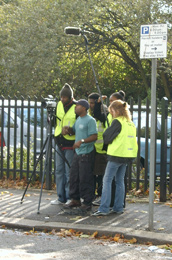 |
Wayne Harrison is with some of the Notting Dale film crew and is checking that everything is running smoothly on a movie called "Tirisano Diamond's". In all types of productions there are advantages to small crews. Aside from keeping the budget lower, small crews can move quickly and gain access to all sorts of locations, such as city streets, small houses or mountaintops, that would be difficult for larger crews. Finding the right crew size is a balancing act. If the crew is too small for the complexity of the production, then crew members become overburdened and the work becomes inefficient and slow. (Wormwood Scrubs Prison), Winter 2004 |
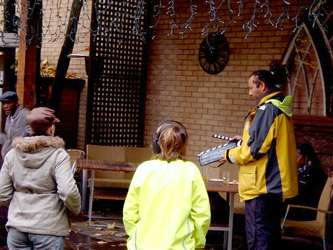 |
Helen Oakleigh has some how managed to persuade Sacha Bowling to do the clapper board filming on location. Shooting on location can be a major advantage as you will have to do minimal set work, merely dressing. (Station House Pub Garden), Autumn 2006 |
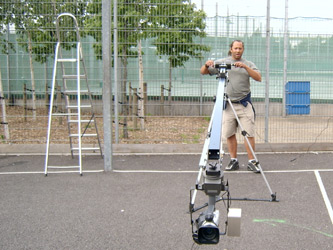 |
Sacha Bowling is balancing the weights on the back of the CamCrane. (Westway Basket Ball Court), Summer 2004 |
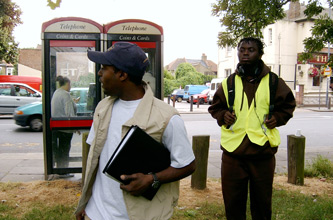 |
Wayne Harrison is making sure that everything is going to plan on the storyboard. A storyboard is a graphical representation of the camera shots in a film sequence which are connected together to create a 'narrative flow'. It is similar in appearance to a comic-strip. Drawing a rough storyboard is the first step a director will take in visualising a script or a screenplay. (North Pole Road), Summer 2004 |
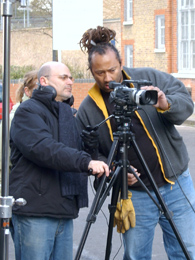 |
Sacha Bowling is checking the framing on Peter Luck's camcorder before he starts recording. (Freston Road), Winter 2006 |
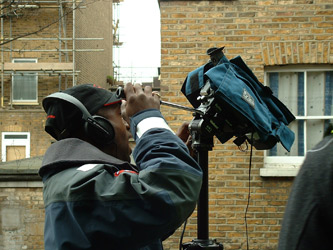 |
Wayne Harrison is helping the students to direct the actor and is also the cameraman on a movie called "Just My Luck" which is written by Patrick Quarshie. (Ion Bar, Ladbroke Grove), Spring 2004 |
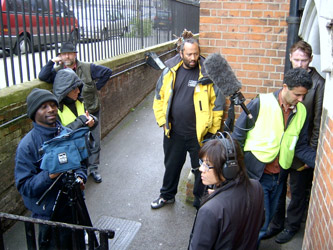 |
The Notting Dale crew are setting-up the film equipment in cold and rainy conditions before the action begins on a film called "The Sweeper". Crews and actors (especially), don't like being cold and wet. Try and work around bad weather, or if the script calls for it, control the weather by creating it with wind and rain machines. (Notting Dale Technology Centre, Basement), Summer 2007 |
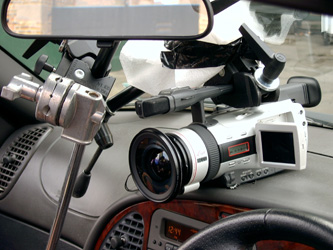 |
This is a closer view of the camcorder being securely mounted onto the dashboard with a wide angle lens attached at the front. (Freston Road), Spring 2004 |
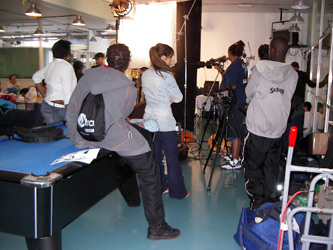 |
Sacha Bowling is setting up the film equipment with the help of students on a movie called "Dead End". Commercials are another aspect of film work. When a company wants to advertise a product they employ and work closely with a TV or film production company. As the 'client' they have final responsibility for how the advert is shot. (Harrow Club), Summer 2004 |
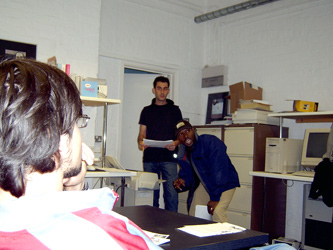 |
Wayne Harrison is working out with the students where they want to position the camcorders before they start filming. When doing a recce take the opportunity to check your plans with security staff, maintenance people and secretaries. They have the power to make your project work by getting noisy air conditioning switched off, unlocking doors or keeping hangers-on out of your way. They also have the power to ruin your whole project if they don't like you. Use the recce to think about your shooting schedule, the angle that looks perfect on an overcast morning may be facing straight into the sun if you come back to shoot on a bright afternoon. Try to allocate specific times for each sequence. (Notting Dale Studios), Summer 2004 |
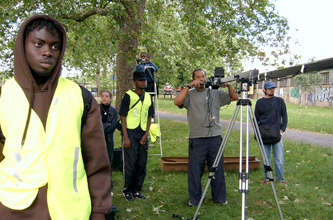 |
Sacha Bowling is operating the CamCrane. (North Pole Road), Summer 2004 |
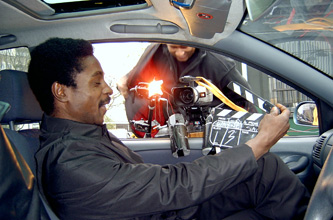 |
Leonard Delapenha is enjoying himself doing some acting on a movie called "Tirisano Diamond's". (Freston Road), Winter 2004 |
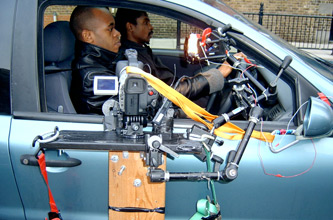 |
Sean Lawson has kindly allowed Notting Dale Video Production to rig the camcorder onto the side of his car. This device was invented by Sacha Bowling as a nice easy way to mount the camcorder on the side of the car very quickly and without any fuss. (Freston Road), Winter 2004 |
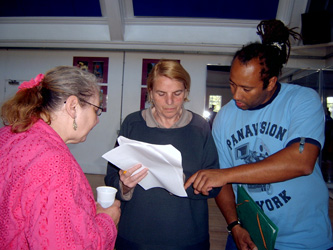 |
Helen Bangoliny is going through the storyboard with Sacha Bowling to make sure their getting the right shots for Carol Ashby who is directing the bedroom scene. Films usually start off with a script and then the ideas are converted into sketches called (storyboard's). This gives the client a visual idea of what is happening, and also the crew and actors so filming can go smoothly. Once the client is happy with the pitch and they decide to invest in the movie, the next step is to schedule the filming on a day to day bases. This will give you some idea of how long it will take for your movie to be made and it will also help with budgeting how much it will cost to make the movie. (Harrow Club Dance Hall), Summer 2006 |
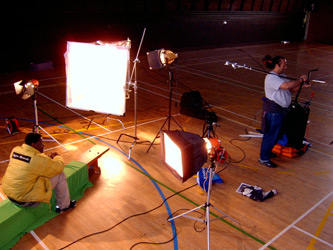 |
Sacha Bowling is setting up the lights, flags, C-stand and frames for the photo shoot. Obviously, the lighting used on location depends not only on the production but also on the location. The most basic requirement for lighting is to provide sufficient light to expose the picture in the camcorder, but lighting can also influence shape, depth, the character of the scene, atmosphere, composition and can direct the eye to a particular part of the scene. Skilful use of light on a face can accentuate or minimise the good or the bad features of the person being filmed. There is no simple rule, for a lot depends on the complexity and size of the production, and how elaborate your treatment is to be. You may be limited by facilities, time or space. When shooting, problems can occur through using mixed light sources. Daylight and tungsten have different colour temperatures, for which the eye makes allowances, but colour film does not! (Harrow Club), Spring 2004 |
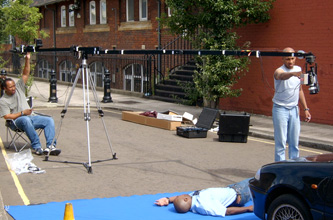 |
Sacha Bowling is operating the CamCrane and Wayne Harrison is doing some acting on a movie called "The Call". (Bard Road), Summer 2005 |
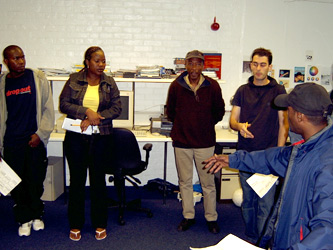 |
Wayne Harrison is working out with the students how they want to film the action on a technical group Recce. One of the nice things about making a film is meeting new people from all different backgrounds. (Notting Dale Studios), Summer 2004 |
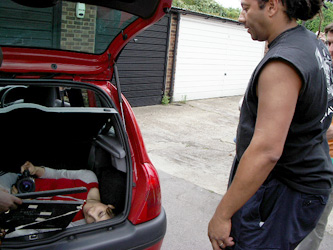 |
Sacha Bowling is giving Hala Hassan instructions on how to operate the camcorder in the boot of the car. (Caverswall Garage), Summer 2004 |
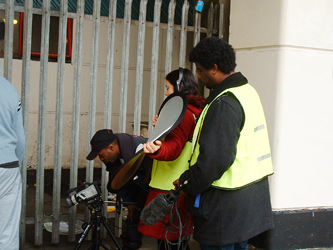 |
Wayne Harrison is checking the exposure and framing on the camcorder before the crew start filming their short film called "Just My Luck". Shorts are excellent for learning the various technical crafts of film making, editing, sound, directing the camera and actors. The structure of a short film is entirely different from that of a feature film. Just because you can tell a story in ten minutes does not necessarily mean you can tell a story in ninety minutes. Don't expand a short screenplay into a feature. This almost always produces a very padded out, slow feature version of a short idea. Start from scratch. Shorts are good to make up a showreel of the work you have done. (Maxilla Walk), Spring 2004 |
 |
Beverley Shirazian and Winston Rutherford are waiting for Sacha Bowling to adjust the polarising filter on the front of the lens by rotating it. On a clear day, some of the light from the sky is polarised, as is light reflected from glass and water, but not metal. Polarised light can be progressively eliminated by rotating the polarised filter. Reflections from glass and water can sometimes be totally eliminated, but be careful not to overdo the effect; otherwise, a car may look as though it has no windshield or a pond as though it is dry. (Station House Pub Garden), Winter 2007 |
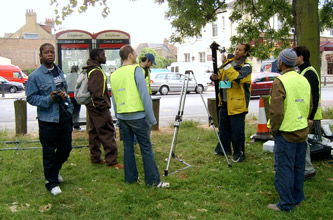 |
Sacha Bowling is starting to put together the CamCrane with the film crew. Remember that making a short or big film is a collaborative art and everybody needs to work together in order to complete the movie. If people aren't doing what their suppose to do and don't take the job serious, the atmosphere can change from very nice to very bad so try and avoid arguments, do your job and you will enjoy the day and learn lots of different skills and techniques because people will want to work with you! (North Pole Road), Summer 2004 |
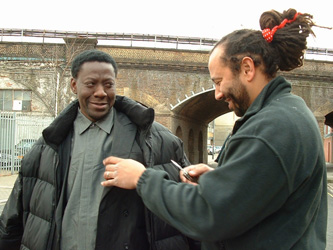 |
Sacha Bowling and Patrick Quarshie, who has decided to do some acting on a movie called "The Agent" are having a laugh and joke before they get down to some serious work. Always make a contract with everyone that appears in front of the camera. Carry release forms that can be filled in on the spot. Not only will this protect you legally, but the sales agent will require these documents. (Freston Road), Spring 2004 |
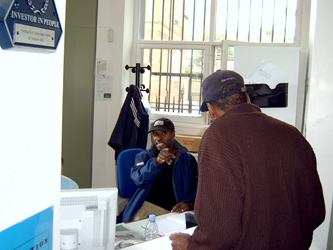 |
Wayne Harrison has a bright idea and is making a suggestion to Claude Johnson. Always follow your instinct, if something is too good to be true, it probably isn't true. (Notting Dale Reception Area), Summer 2004 |
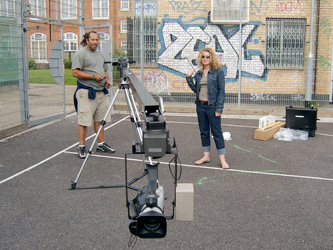 |
Sacha Bowling is trying out the remote control on the CamCrane's power head which will move the camcorder in any direction with the press of a button. (Westway Basket Ball Court), Summer 2004 |
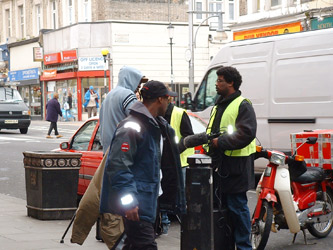 |
Wayne Harrison is checking that the film crew have everything correctly set-up before they start filming. One of the most challenging aspects of working in television and film is getting the work! There is plenty of work available but many people trying to get it. It takes courage and determination, but offers a very varied and exciting career. (Ladbroke Grove High Street), Spring 2004 |
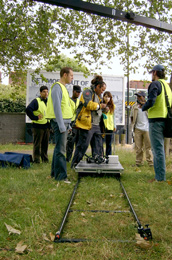 |
Sacha Bowling is rigging the camcorder to the dolly by using a magic arm. (North Pole Road), Summer 2004 |
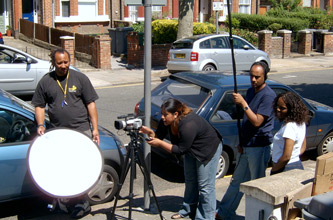 |
Sacha Bowling is helping out the students by being the gaffer on a movie called "Final Cut". Ultimately, when making a movie the work has to be done come rain or shine and it may be that compromises have to be made by all. Very often location work can be extremely frustrating, not having the right facilities or trying to keep an artist looking presentable in a gale force wind! Tolerance, patience and understanding are all necessary qualities for this kind of work. If you have these, location work is fun. It is challenging, healthier than working in a studio, friendlier as you work in closer union with other departments and, at the end of the day, if it is horrible, you know it will end and you need never go there again! (Chevening Road), Summer 2005 |
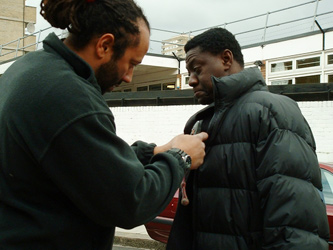 |
Sacha Bowling is starting to cut the jacket that Patrick Quarshie is wearing so the fake blood can come out with no problem, once the pump compressor is released. (Freston Road), Spring 2004 |
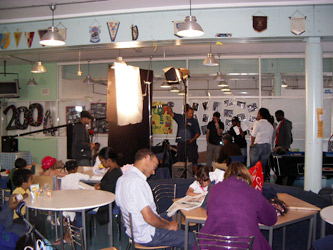 |
The Notting Dale film crew have the lighting equipment set-up and are ready to start filming. Location lighting usually involves more improvisation and compromise. Lighting complexity varies considerably between productions. Some rely on a quick impromptu set-up; others give an opportunity to install a full lighting rig. Anticipation and adaptability are essential, when shooting on location. When the interior is spacious, and you have only a few lighting fixtures, your options are limited. The best solution is to restrict how much the camcorder can see. Use close shots. Use a window, door or arch to cut off part of the distant scene. Sometimes you can mask-off the action area with lightweight screens. Perhaps you can light just a small section of the interior, shoot the action there, and then go on to light the next adjoining section. Edited together, action can look continuous. Generally speaking, where space is very limited, softer light of lower intensity is most useful. (Harrow Club), Summer 2004 |
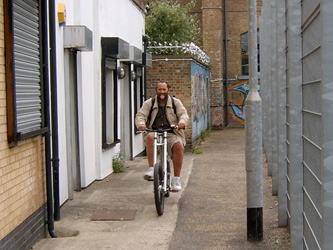 |
Sacha Bowling is enjoying himself as he rides around on his Los Angles bike. (Westway Basket Ball Court), Summer 2007 |
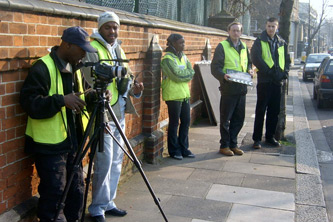 |
Wayne Harrison is checking the framing before Mohamed Omar starts to operate the camcorder on a movie called "Tirisano Diamond's". (Peterborough Road), Winter 2005 |
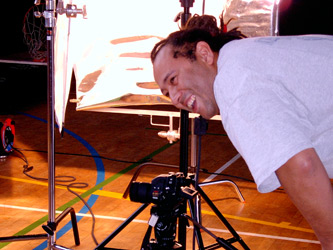 |
Sacha Bowling is enjoying himself behind the stills camera. (Harrow Club), Spring 2004 |
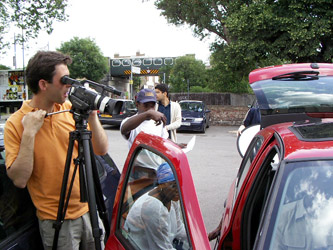 |
Wayne Harrison is reading out the shooting script and giving Claude Johnson and the film crew instructions. A Shooting script is the final version of a script with the scenes arranged in proper sequence for making a movie or TV program. (Pavilion Car Park), Summer 2004 |
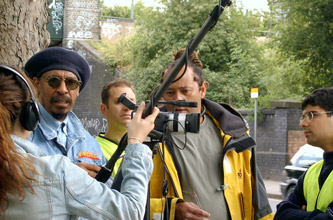 |
Sacha Bowling is checking the sound levels and exposure on the camcorder. (North Pole Road), Summer 2004 |
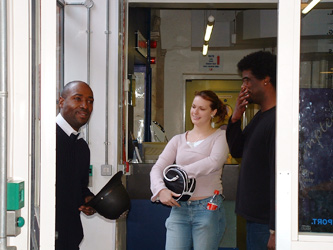 |
Wayne Harrison is wearing his costume and is preparing to do some acting as a police man. The students seem convinced that he looks the part for the job. Film and TV costume houses are not as expensive as you may think! Give them a call and set-up a meeting to view their warehouses, it's astounding what they have and everything is negotiable.Most large studios retain a wardrobe department including some modern dress items worn regularly in films such as formal evening wear, uniforms for nurses, police and servicemen and so on, together with period costumes perhaps specially made for a previous film. Loud patterns and colours which distract from the performer are best avoided. The same may be said for highly contrasting colours, which could be beyond the tonal reproductive range of the film. Black dinner jackets and white shirts have always posed a contrast problem, usually overcome by wearing of shirts tinted light blue. Clothes should be comfortable, look natural and preferably not so fashionable that they 'date' the film. Where possible, clothes should contrast with the background! (Harrow Club), Spring 2004 |
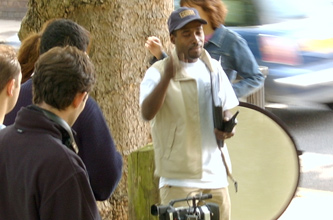 |
Wayne Harrison is running around and telling the students how he wants the action to be filmed. The pressure and anxiety the directorial process creates can kill a career before it's had a chance to screw up on its own. Much of the pressure of directing comes from trying to fix compounded errors. You make a little mistake in casting or skimp on a location, and then whenever it comes up, instead of addressing it you aggravate the situation further by trying to work around it. These compounding phenomena have taken down many directors and their productions, large and small. Always nip mistakes in the bud! (North Pole Road), Summer 2004 |
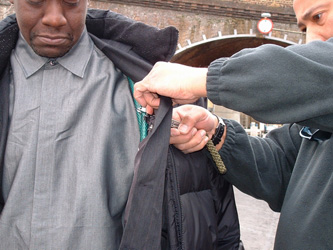 |
Sacha Bowling is cutting through the jacket which cost £10.00 to buy from an Oxfam shop. When approaching people for deals or freebies, be polite and don't try and hustle. Most people who are in the industry have been in it for many years and can spot ignorance and arrogance a mile away. Both these qualities are not desirable. Go to a person for help and advice, everyone likes to help someone out, it makes them feel good inside. If you can't get a discount, get something thrown in for free. Remember to say thank you afterwards and if you can, send a bottle of wine or even chocolates and flowers. Whatever the gift, it will be appreciated. Follow up thank you letters will often get a repeat performance if it is needed. (Freston Road), Spring 2004 |
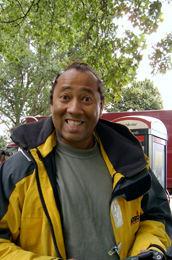 |
Sacha Bowling has time to give us a big smile. (North Pole Road), Summer 2004 |
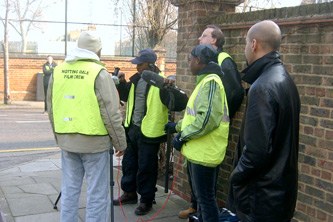 |
Wayne Harrison is checking the sound levels. Sound is an area that is neglected by most inexperienced film makers. "We'll fix it in the cutting room" usually means several thousand pounds of post production (opposed to 3 minutes on set, for another take). Don't believe anyone when they tell you that it is possible to filter out the camera noise. It is possible to filter most out, but never all. A heavy atmosphere track could cover this problem. Good track laying in post production doesn't cost the earth and makes the film sound much more expensive. Post sync dialogue is a pain and very expensive. Try and avoid it! (Peterborough Road), Winter 2005 |
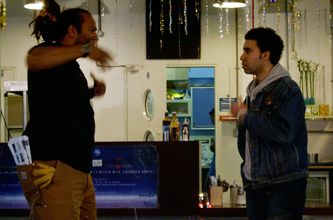 |
Sacha Bowling is showing Ivan Todorov how he wants him to act for a particular scene in his movie called "TERRORIST". It is the director's responsibility to ensure that the actor understands what is expected of him. He will need to be told how the director sees the part in relation to other characters and to other scenes in the film; but in general the visualisation of a part is best left to the actor to create. The director can subsequently suggest modifications to polish a performance, rather than risk initially stifling the actors contribution by giving rigid directions. (Harrow Club), Winter 2006 |
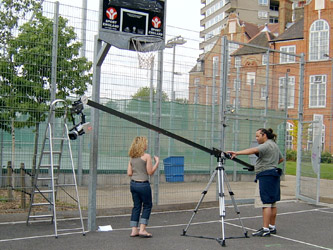 |
Sacha Bowling and Jenny Grogan are having fun playing around with the CamCrane. (Westway Basket Ball Court), Summer 2004 |
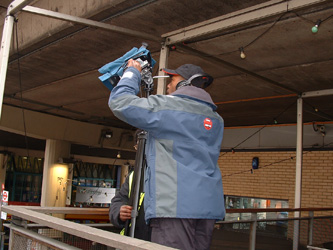 |
Wayne Harrison is in deep concentration as he operates the camcorder and tries to get the perfect shot for his students short film. The obvious starting point when making a low budget film is to make a short. Whilst your short may be a great movie, it isn't a feature and you will have terrible problems trying to sell it to get your money back. A feature film is a saleable product which will generate interest from buyers. A short will generate virtually no interest. If you make a great short film, you could get an Oscar nomination, in which case, your career is seriously boosted. (Ion Bar, Ladbroke Grove), Spring 2004 |
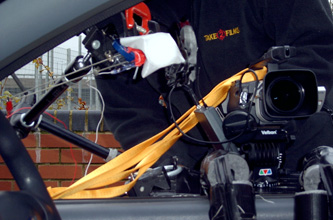 |
Sacha Bowling is making sure that the camcorder is securely attached to the side of the car. Sacha has recently started inventing his own rigging devices for Notting Dale Video Productions and the first is the car side mount. He has a few more pretty impressive rigging devices in progress which he is planning to use on his short movie called "Chasaneway"! (Freston Road), Winter 2005 |
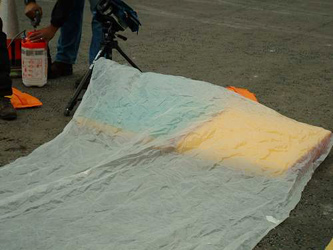 |
It is very important to have a crash mat if your actor is going to perform a simple stunt such as falling onto the concrete floor. If he or she gets hurt in the process, that could mean a long delay in completing the movie or your main actor just doesn't want to act for you anymore because you didn't look after them in the first place, which means the movie will never be completed. Where production might be held up if an actor is injured, stunt artists and doubles are used for dangerous or difficult scenes. Stand-ins are similar in height and colour to actors for whom they stand in while lights and camcorders are positioned. (Freston Road), Spring 2004 |
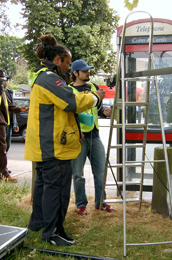 |
Sacha Bowling is assembling the CamCrane together. (North Pole Road), Summer 2004 |
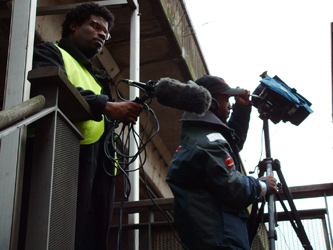 |
Wayne Harrison is adjusting the tripod higher so that he can get a better shot. The 'standard' or 'normal' lens covers a field of view which the human eye normally sees. A complete film could be shot with this one 'standard' lens but the effort, making repeated changes in camcorder position from long shot to close-up, would be exhausting and the result would be visually monotonous. For example, a camcorder and standard lens at the back of a theatre records the show entirely in long shot, but without the excitement of close-ups and medium shots which different lenses and positions provide. The result seems boring and audience attention diminishes. This is because it is unnatural for the human eye to stare fixedly at a scene for long periods; it flicks naturally from long shot to close-up. To produce greater interest in the scene, lenses of different focal length can be used, ranging from 1000 mm lens for a close-up of a distant football player, to a lens of just a few mm focal length for a 'fish-eye' view, including almost both ears of the camera operator. (Ion Bar, Ladbroke Grove), Spring 2004 |
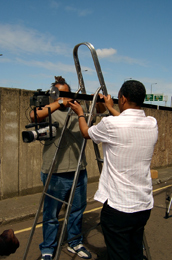 |
Sacha Bowling is setting up the CamCrane with the help of Abraham Kidanemariam. (Bard Road), Summer 2005 |
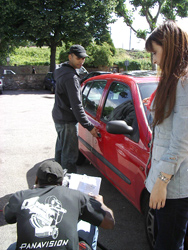 |
Wayne Harrison is checking the framing, aperture and depth of field before Hala Hassan operates the camcorder. Depth of field is the range of distance (measured along the lens axis) for which the subject is rendered acceptably sharp in the photographic image. Sometimes by depth of field we mean the capability of a lens to render subjects placed at various distances acceptably sharp. In practice, the camcorder lens is in sharp focus at one distance only at any time. The depth of this toleration (i.e. depth of field) can be increased with wider angle lenses and smaller apertures. The camera operator therefore focuses on the most important item in the scene. As the distance between camcorder and subject alters, he/she adjusts the focus while shooting (following focus) to maintain the sharpest image. (Pavilion Car Park), Summer 2004 |
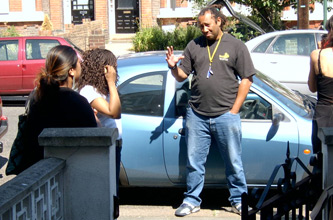 |
Sacha Bowling is describing to the students how it would be on a big film set, like in Hollywood. As audiences never even consider that a film set has no ceiling and only two or three sides, it follows that many other deceptions can be perpetrated. Actors look out of windows on sets and in reality probably see only cables and lamps. But if in the finished film a view of the New York skyline is shown next, the audience assumes that this is what the actor sees! (Chevening Road), Summer 2005 |
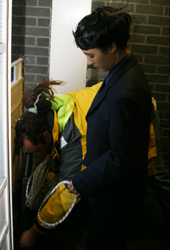 |
Sacha Bowling is helping Kimberly Robinson with the rope on a movie called "The Agent" . (Frinstead House Tower Block, Freston Road), Spring 2004 |
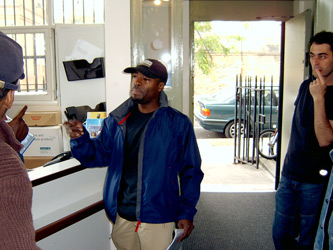 |
Wayne Harrison is talking with the students and getting some ideas about how they want to film the action on a movie called "Highest". A film without sound is called a silent movie. A film without light is called radio. Exposure and contrast are two essential elements of selective visibility in cinematography. Much of the artistry of cinematography is in the control of lightness and darkness throughout the film's latitude, selectively exposing objects and characters to appear bright and glowing, slightly shaded, darkly shaded, barely visible or completely lost in darkness, as desired. The way the cinematographer lights the set and sets the exposure determines the various values of the scene. (Notting Dale Reception Area), Summer 2004 |
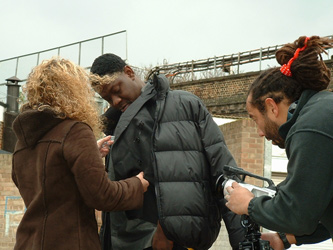 |
Jenny Grogan is in-charge of wardrobe and makeup. She is watching Sacha Bowling as he frames up the camcorder for the bullet-hit shot. (Freston Road), Spring 2004 |
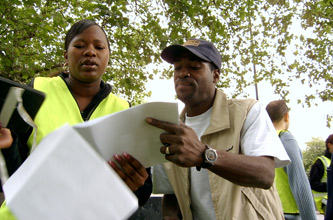 |
Wayne Harrison is showing Sisasenkosi Ncube what part of the script is being filmed so she can write down the scene number on the clapperboard. Like any industry, film production is not without its much despised paperwork. While the trick is to keep it to a minimum, there is a definite need for some records to be kept, even in the smallest unit. (North Pole Road), Summer 2004 |
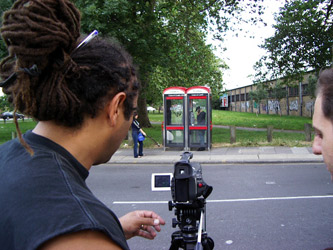 |
Sacha Bowling is showing Majid Haji Nowrouzi how to operate the camcorder. For the most part, video is a lot easier to shoot than film. Because tape is cheap and comes in long, easy-to-load cassettes, shooting video can be much more relaxed than film. You can take more risks with things that might not work out. If you're interviewing someone for a documentary, and he/she takes a long time to loosen up, you can keep shooting until he/she does without fretting about the cost. Even so, shooting a lot of footage isn't always better than shooting less. (North Pole Road), Summer 2004 |
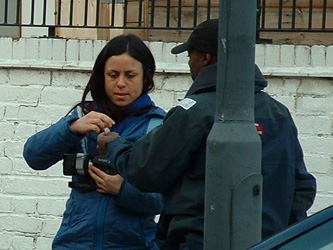 |
Wayne Harrison is giving Nadia Petean a twenty pence coin to screw the quick release plate onto the camcorder so that it can be securely mounted onto the tripod. (Freston Road), Spring 2004 |
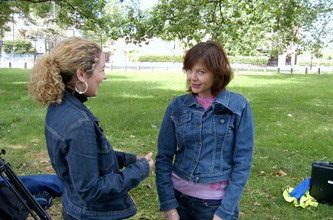 |
Victoria Trudgeon and Jenny Grogan are having a laugh and joke whilst they are making a movie called "Dead End". (North Pole Road), Summer 2004 |
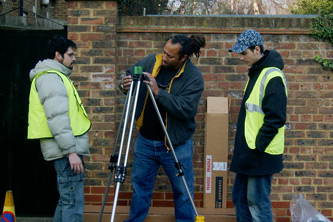 |
Sacha Bowling is setting up the tripod for the CamCrane and is being watched very closely by Jorge Moya and Satish Gregory-Pujji. When shooting in a studio, with all the necessary support departments close to hand, almost any item needed can be quickly obtained. On location, when a production can be held up for the want of one small piece of equipment, the tendency is to take everything possible plus some spares i.e. trucks, lamps, cables, camcorder and canteen, often creating for the onlooker a more entertaining performance than that provided by the cast. For the smaller film unit, the support facilities will be less, but the problems remain the same. A missing lead or seemingly insignificant item can stop or delay a production, causing difficulties and extra cost. Simple check lists avoid a lot of problems. After each days shooting, items can then be ticked off to ensure nothing goes astray or is left behind! (Peterborough Road), Winter 2005 |
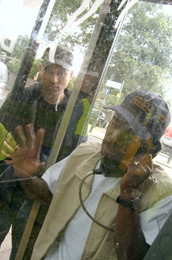 |
Wayne Harrison is the director, producer and script writer for a movie called "Dead End". Films generally start as a treatment or a script, which is broken down into a shooting schedule. With feature films, once shooting commences, a daily call sheet is issued by the production office. This lists the artists required on the following day and the location or stage on which they will be either working or on stand by. The starting time and any other special items are also noted. Copies are circulated to almost every department so that, for instance, transport and catering requirements can be calculated, as well as the artists salaries. Similarly a daily progress report is issued. A daily cost control check is maintained by adding the production unit's salaries (director, camera and recording crews, hairdressing, make-up, wardrobe, editing, projection etc.), the set designing and construction costs, plus publicity, overheads, insurances and materials, to ensure that expenditure conforms to stipulated budgets. (North Pole Road), Summer 2004 |
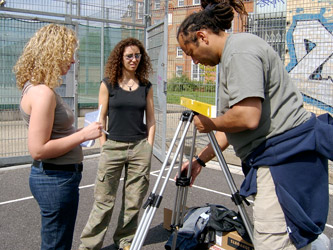 |
Sacha Bowling is showing Jenny Grogan and Kimberly Robinson how to set-up the tripod properly for the CamCrane by making sure that it is level so it doesn't tip over. (Westway Basket Ball Court), Summer 2004 |
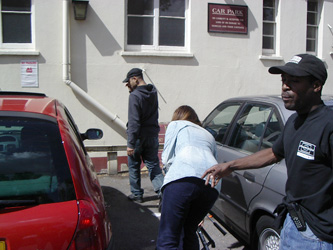 |
Wayne Harrison is telling the students what to do and directing the actor. Movie makers are predisposed to the one-way narrative, and as such need to maintain a strong visual presence in the mind's eye of the texture and pacing of the story elements. The director must also keep in mind the progression of various character arcs and how they interrelate, even though subsequent scenes in a picture might be shot months apart. As with any creative medium, there is no guaranteed formula for success; if there were, every film made for cinema would be a box-office hit and every sales film would empty the sponsors factory overnight. The message of the film should be clear and the main objective defined at the outset. It may be that the aim is simply to entertain; but all films must do this, whether or not actors, singers and dancers are used. The entertainment can be in the way picture and sound are presented. This applies equally to fictional films and to documentaries or films made to promote and instruct. It is helpful to make a rough list of the items to be covered from which the main message and story approach can be selected. (Pavilion Car Park), Summer 2004 |
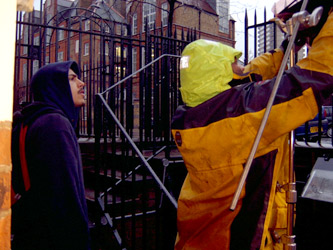 |
Alli Shelton is checking out Sacha Bowling's lighting set-up. You can apply lighting know-how to any situation you are shooting. Even when the light that is already there, happens to give excellent results, a knowledge of lighting principles can help you towards more effective picture-making. Simply by angling the subject or repositioning it, or altering the camcorder's viewpoint, you will often find that you can considerably improve picture impact. Sometimes, you can enhance the existing lighting by reflecting light onto the subject from another angle, or adding some extra illumination. (Notting Dale Technology Centre, Basement Office), Winter 2007 |
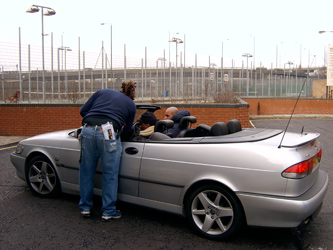 |
Sacha Bowling is making sure that the actors are safe and comfortable in the car. (Freston Road), Spring 2004 |
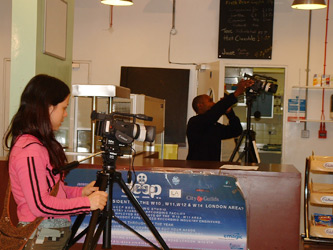 |
Wayne Harrison is operating the second camcorder after finishing his acting as a police man on a movie called "Just My Luck". Notting Dale Video Productions like to use multiple camcorders. This is because by using multiple camcorders you can cut the on-set time nearly in half. Since the actor knows that there are several angles being shot at once, they will want to put more effort into the portrayal. In conventional film production the whole process is so convoluted with DP's and their crews, loading, cleaning, checking and logging each shot that hardly anyone ever uses multiple camcorders. (Harrow Club), Spring 2004 |
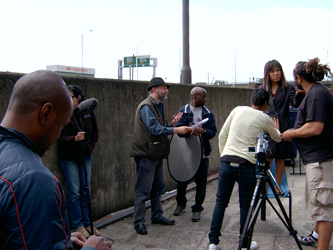 |
The Notting Dale film crew are working very hard during the day as a team with the help of Sacha Bowling to make a short movie called "Runnin'", which was written and produced by Kevin Cadoo. If your film is set at night, it will take longer to shoot as every shot will need to be lit. If you shoot during the day, it's possible to get away with little or no lighting. Consider the possibilities of moving the production outdoors as much as possible during the hours of daylight. It is easier to manage an outdoor location, and there is less to damage. Shooting outdoors can be a problem as there is no way to control the weather. Consider shooting in a place like Spain where there are long days with great light. The locations will be cheap too, but try and learn the language first! (Bard Road), Summer 2007 |
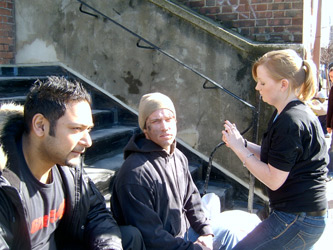 |
Samantha Cox is a very good friend of Beverley Shirazian and she has kindly decided to help her friend out by doing the make-up for her short movie called "Reflections". For make-up staff there is a difference between TV and film. For much TV work the make-up and hair requirements are simple and straightforward. It was probably for this reason that the make-up artist was also expected to do any hairdressing required. When television began to produce entertainment, especially period drama, the make-up artist had to learn appropriate hairdressing skills. (Bard Road), Winter 2007 |
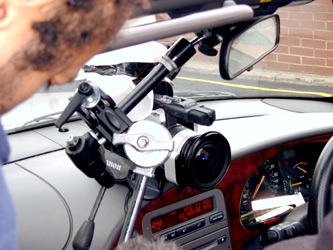 |
The camcorder has been properly and carefully secured to the dashboard so when the car is driving at fast speed the camcorder doesn't shake or move around. (Freston Road), Spring 2004 |
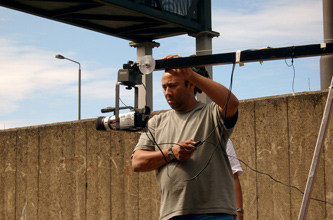 |
Sacha Bowling is making sure that the CamCrane's Power Head is working properly by testing it with the remote control. (Bard Road), Summer 2005 |
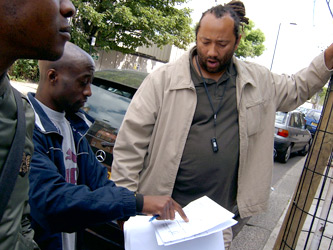 |
Kevin Cadoo is checking with Sacha Bowling and making sure that all of the shots on the storyboard's have been covered before they move onto the next scene on his movie called "Runnin'". Don't be afraid to drop your boards if time, money, locations or miscellaneous nightmares make them too difficult to shoot. Storyboarding allows you to think creatively, without pressure. Making it up the day before, or even in the car on the way to the set is hardly conducive to creative thinking. Don't underestimate how long it will take to board your film, you are talking about 700 - 1000 hand drawn pictures with descriptions, all of which will need photocopying. If you can afford it, buy one of the dedicated Storyboard's programs for your computer. It will speed up your work and present a more professional image, unless you can get a professional artist. (Freston Road), Summer 2007 |
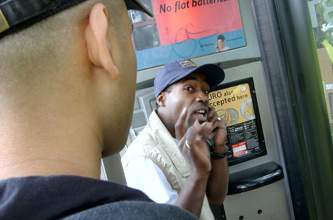 |
Wayne Harrison is telling Aminur Rahman what direction he wants him to be looking when he is on the telephone. A shorter running time allows the film maker more freedom of expression in the sense that the character can be examined with less subordination to the all-important plot of a feature. With lower budget, film makers remain in firm control. Commercial restrictions that can inhibit feature film makers, keeping them from taking risks with their work, don't apply to the short film. (North Pole Road), Summer 2004 |
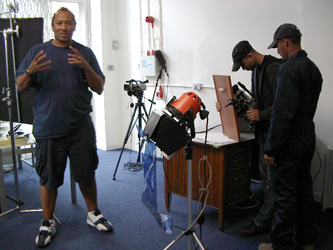 |
Sacha Bowling is explaining to the students how dangerous working with studio lights can be. Lights get very hot and can easily start a fire. Common sense and proper care are essential to the prevention of accidents. In the event of a small fire, a quick electrician may be able to smother the flames with gloved hands or with a furniture pad. Know where the fire extinguisher are situated. An electrician with a good nose and good eyes can detect a potential fire before it becomes serious. If you smell smoke, don't cause a panic, but let the other electricians and grips know so they can help look for the source. (Notting Dale Studios), Summer 2004 |
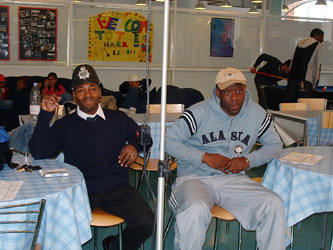 |
Wayne Harrison and Patrick Quarshie are relaxing before they are called back onto the film set for filming a movie called "Just My Luck". Keep a walkman with you so you can listen to music to take you away from the set in order to clear your mind. (Harrow Club), Spring 2004 |
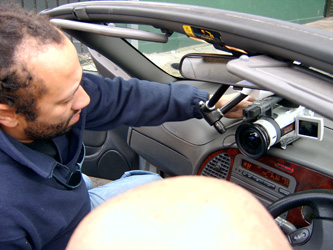 |
Sacha Bowling is making sure that the camcorder is correctly positioned onto the dashboard by using his rigging tools. Keep a close eye on tools, they are expensive and have a tendency to go walkie's. (Freston Road), Spring 2004 |
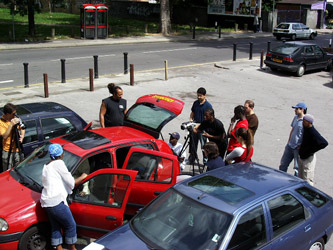 |
Wayne Harrison and Sacha Bowling are teaching the students how to make a short movie and also what it takes to be a good film director. The Notting Dale film crew are filming with two camcorders so that they can get more coverage of the scene being filmed. The more coverage you get now, the more choices you'll have later in the editing room. Although improvements in editing machines make the work quicker and easier, so far none have been invented which dispense with the expertise of a film editor. It is his job, usually working in conjunction with the director, to select the best takes and first compile the jigsaw of film pieces into a rough assembly. Where a detailed script with numbered scenes is being followed the editor works closely to this in preparing the work print. Basically, the editor ensures that the shots follow each other correctly, accompanied by the appropriate sound. (Pavilion Car Park), Summer 2004 |
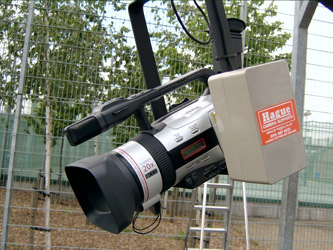 |
This is a close-up of the Canon XM2 which is mounted onto the CamCrane's Power Head which is controlled by a remote control. From the largest camcorder to the smallest piece of equipment, all can be hired by the day or week, either as single items or as part of an entire package, enabling an independent producer to shoot and edit where he or she wishes! (Westway Basket Ball Court), Summer 2004 |
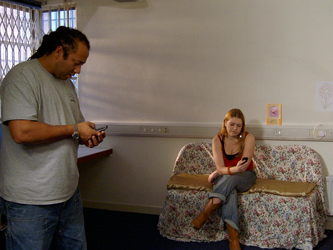 |
Helen Oakleigh and Sacha Bowling are exchanging phone numbers so when she receives the call, a name will appear on the screen saying "Oberon" on a movie called "A Midsummer Nightmare". (Notting Dale Technology Centre, Room 1), Autumn 2006 |
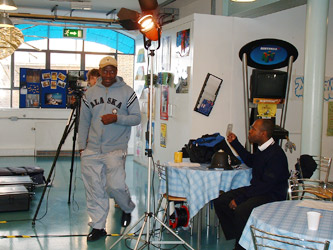 |
Wayne Harrison and Patrick Quarshie are doing some acting on a movie called "Just My Luck", and they are discussing how the action should be before they start filming. Actors are more fussy than crew and often expect to be treated better than you can afford. Be aware of this very important factor. (Harrow Club), Spring 2004 |
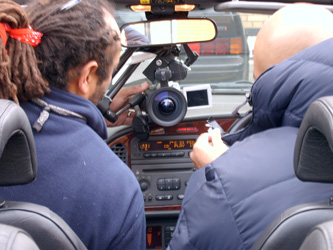 |
Sacha Bowling is discussing with Delroy Beaton how he feels about the camcorder being rigged to the dashboard of his car. (Freston Road), Spring 2004 |
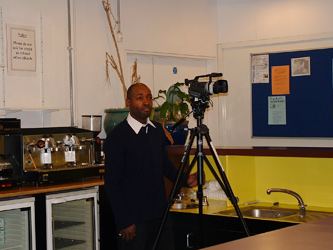 |
Wayne Harrison is on the camcorder and is waiting for the action to begin. Usually several takes of the same scripted action are shot, in part because actors blunder and crew members make technical errors, and in part because shooting multiple camera angles minimizes the chance of discontinuities in the edited sequence. It is also important to give the editor a choice of cutting points, actions are always overlapped at the front and end of a scene. Most importantly continuity is the flow of elements that pulls the audience along. A film's greatest asset is that it moves. As it does so, a film presents scenes with such realism that they take on a feeling of immediacy. No matter when the film was made, to the audience the events are happening now. People watching become involved and this makes the film director's job a lot easier. This ability to move people's emotions has been developed considerably, so that films now have a multitude of uses outside cinema and domestic television! (Harrow Club), Spring 2004 |
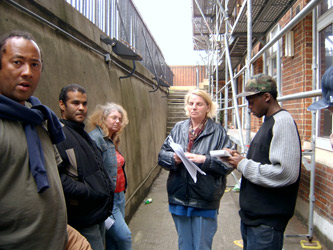 |
The Notting Dale film crew are thinking very hard about if they should include this location in their film called "Deceit", but the only problem is the noise from the motorway behind, which will effect the dialogue of the actors. When looking for locations, bear the sound in mind. Traffic and planes are usually the worst culprits. Natural conditions for recording can often result in unnatural sound recordings. The problem is that the microphone, unlike the ear, cannot select individual sounds. Background sounds might be at such a high level that the performer must shout to be properly heard. Most natural sounds can be covered up and disguised in post production. (Bard Road), Summer 2006 |
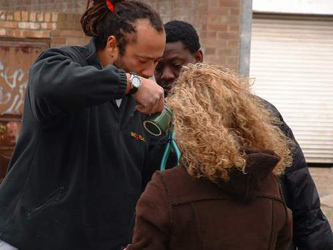 |
Sacha Bowling is pouring the fake blood into the pump compressor, watched anxiously by students. (Freston Road), Spring 2004 |
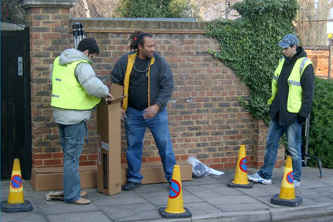 |
Sacha Bowling is starting to set-up the CamCrane with the help of Jorge Moya and Satish Gregory-Pujji. (Peterborough Road), Winter 2005 |
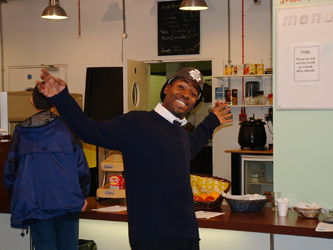 |
Wayne Harrison enjoy's doing acting for his students, and is having fun pretending to be a police man. An actor who tries to have a feeling on demand looks like an actor. (Harrow Club), Spring 2004 |
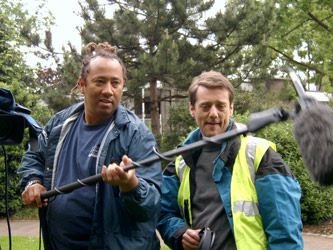 |
Scott Carpenter is getting a lesson from Sacha Bowling about how to hold the sound boom pole correctly and wrap the cable around the pole so it doesn't fall into the shot. (Westway Park), Summer 2006 |
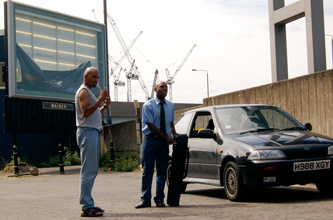 |
Wayne Harrison is trying to finding out exactly what Pablo G wants him to do on a movie called "The Call". People are complex. They may say one thing while doing another, but they are not actually able to do two thing at once. Divergent emotions cancel each other out, so the actor or actress ends up faking them both. (Bard Road), Summer 2005 |
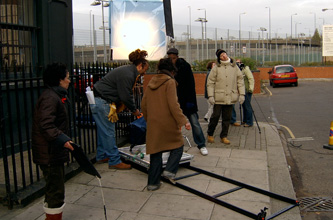 |
The Notting Dale Film Crew are helping Sacha Bowling to set-up the dolly and track on his movie called "TERRORIST". This is so the camcorder can physically travel forward or backward through the depth of a scene without alteration of the focal length of the lens. Where no perspective exists, such as on a flat title card, the zoom offers a smoother alternative to tracking! (Freston Road), Winter 2006 |
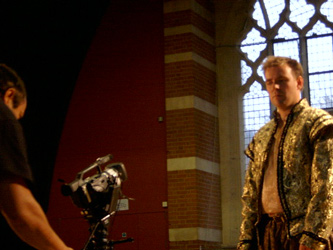 |
Richard Stride is about to begin acting and is waiting for Sacha Bowling to do the final checks. Several low budget pictures have allowed investors to act in their film in return for cash. It works and everyone is happy. Beware of problems if their scene is cut, make this possibility known in advance. If things are going badly, let them know. As long as there is trust and they can see that you have done everything possible, investors have no real come back. Give them a credit on the end of the film. (Harrow Club Sports Hall), Autumn 2006 |
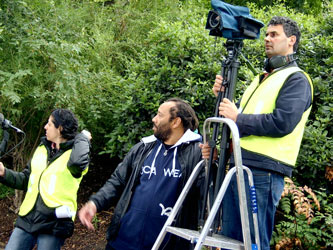 |
Sacha Bowling is helping Kamel Souiad support the tripod which is high on the ladder. A requirement essential to camcorder's is that the mounting head be freely movable to pan or tilt during shooting. Friction heads are the simplest, employing greased fibre washers which offer resistance to pressure on the panning handle. These are lightest, cheapest and most rugged. Fluid heads offer resistance by forcing liquid through a small aperture to give a more positive and smoother action. Gyro-heads incorporate a heavy gyroscopic flywheel to create very smooth action, but are unsuitable for fast movements. Geared heads are operated by rotating geared pan and tilt handles for the finest precision. Tripods with metal-tub legs are the most commonly used on location shooting. Heavier tripods provide the firmest base but they can be tiring and can cause delay when frequent changes of camcorder position are necessary. (Westway), Summer 2007 |
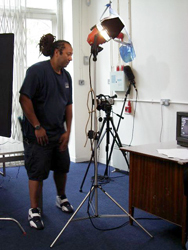 |
Sacha Bowling is the gaffer and is adjusting the barn doors on one of the studio lights. Barn doors provide the most basic control over the placement of the edges of the beam of a Fresnel or open-face lantern. Because the doors are so close to the lantern, the cut-off is fairly soft. Gels and diffusion materials are often attached to the barn doors, where the heat is less intense. Common repairs include changing the lamp, replacing the power switch or plug, reconnecting the power cord to the head, repairing the flood-spot mechanism and cleaning corroded contacts with contact cleaner. Most lights are not too complicated and can easily be repaired if replacement parts can be obtained. Before starting any type of repair, double-check that the fixture is disconnected from the power. (Notting Dale Studios), Summer 2004 |
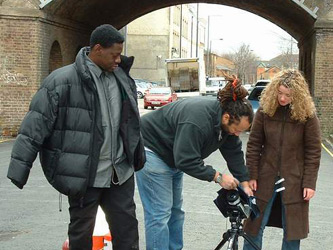 |
Sacha Bowling is putting a rain cover over the camcorder to protect it from fake blood getting inside and damaging the mechanism. (Freston Road), Spring 2004 |
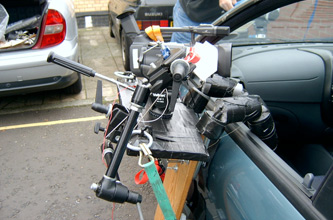 |
This is a side view of Sacha Bowling's car side mount invention. He has attached two metal bars at the back of the vertical plank of wood which has foam around it and curves over. The curve acts as a claw that grips onto the side of the car door. (Freston Road), Winter 2005 |
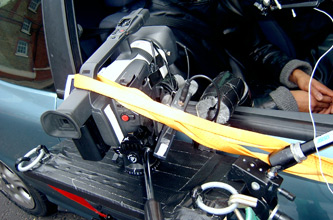 |
This is a top view of the car side mount invention. A safety strap has been attached to the camcorder because you never can tell what could happen, and its always better to be safe than sorry! (Freston Road), Winter 2005 |
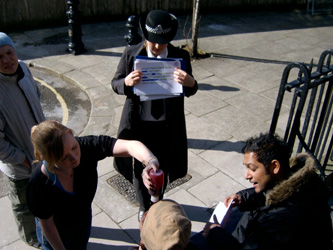 |
Lynn Tibby is holding up an idiot board so that Christian Moore can rehearse his lines whilst he is getting make-up done by Samantha Cox on a movie called "Reflections". At the end of the day, when everyone else is going home, make-up, hair and wardrobe staff will still be cleaning off make-up, collecting wigs, washing and ironing and generally preparing for the next day's work. (Bard Road), Winter 2007 |
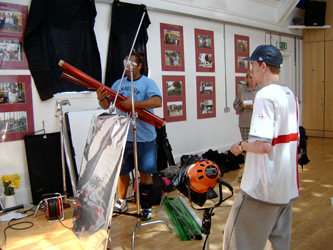 |
David Perez is helping Sacha Bowling set-up the lights. The quality of the light can be manipulated using gel frames to alter colour or to diffuse the light. Because the raw light from an open-face lantern is often hard and unattractive, cinematographers often seek to soften the source. Bouncing the units into silver umbrellas provides a large, yet lightweight, source of soft light. When a set is well designed and carefully lit, the results look so obviously right. The pictures have a strong visual appeal. The atmosphere is completely convincing. But the mechanics and techniques that underly the effect are hidden and self-effacing. Whether you are lighting a studio setting or an actual room on location, always begin with a clear idea of the overall effect you are aiming at. (Harrow Club Dance Hall), Summer 2006 |
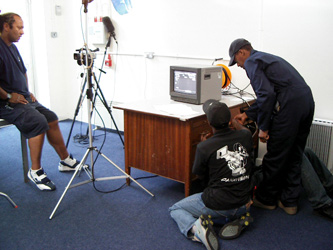 |
Wayne Harrison is telling Neil Patterson how he wants the action to be performed. Work through your script with the actors. If you can't get them all before the shoot, substitute with other actors. It's important to read your script out loud and move actors around in space so that you can get a feel for anything that isn't working. Don't try to make the greatest film ever. Work hard and be creative but recognise that this one will probably be all about learning. (Notting Dale Studios), Summer 2004 |
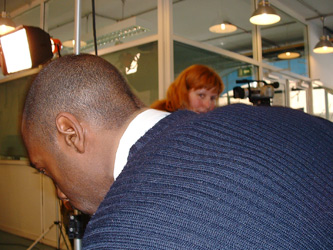 |
Wayne Harrison is showing the students how to set-up a studio light stand properly. Protecting the floor becomes a concern when shooting in a private home or in a set where the floors might be scratched by metal stands. A number of precautions can be taken. One is to put crutch tips on the feet of each stand. Tape the rubber tips in place with gaffer's tape. A stock of crutch tips should be ordered in advance after the location is initially scouted. When a lamp fails, be sure to label the light so that it doesn't get brought back on to the set by mistake. Put an X across the lens with 1-in. tape, and write 'NG' (no good) or 'BO' (burned out) on it. If you know what is wrong with the light, write that on it also (for example, blown lamp, bad switch, bad plug). (Harrow Club), Spring 2004 |
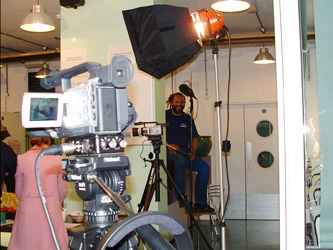 |
Sacha Bowling is relaxing before he starts his role as a sound boom operator for the students movie called "Just My Luck" written by Patrick Quarshie. The boom operator is the person who actually positions the microphone within range of the actors, either by holding it on a pole over their heads, by wiring them with radio mikes or by planting hidden microphones on the set. The boom operator has to contend with shadows cast on to the actors and backgrounds by the microphone and boom pole. Boom operators are very good at analysing the lighting and sometimes have to go through all sorts of contortions to avoid casting shadows. (Harrow Club), Spring 2004 |
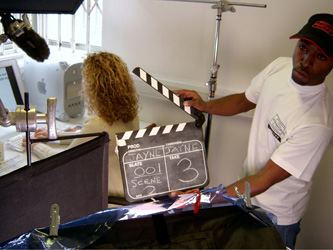 |
Wayne Harrison is marking the shot by using a clapperboard. This visually gives the slate, scene and take number of a shot which would also be announced by the clapper boy. When shooting video, sound and picture are recorded on the same tape meaning they're always in sync. In double-system filming, picture and sound are recorded separately, and the sound must be correctly lined up with the image during post-production, that is, sound and picture must be put in sync. Syncing is much easier to do if there is some distinct event that can be seen clearly in the picture and heard on the sound track. Always allow five seconds where both sound and camcorder are rolling before marking and calling action. (Notting Dale Technology Centre, Room 1), Spring 2004 |
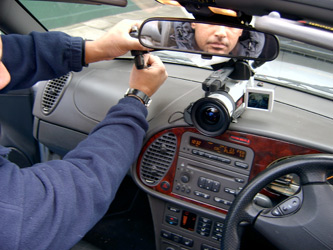 |
Sacha Bowling is making sure that the magic arm is securely locked into position before Delroy Beaton starts driving his car around West London for filming. (Freston Road), Spring 2004 |
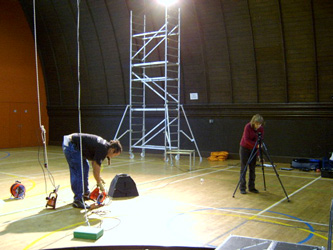 |
Jessica Jacobs is busy setting up the camcorder whilst Sacha Bowling is setting up the lights. You don't have to work on set long before you see that in a rush people can forget their common sense. This is how people get hurt and equipment get broken. Make safe work practices habitual, and you will avoid needless injuries, especially when working under pressure. Work swiftly but never run! (Harrow Club Sports Hall), Autumn 2006 |
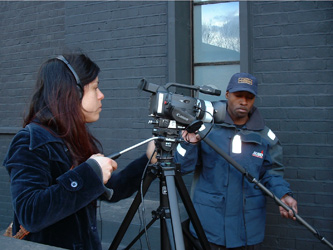 |
Wayne Harrison is sound boom operator on a movie called "Chain Reaction" written by Jayne Norris. Most camcorders have microphones built into the camera. These are simple and convenient, but may result in inferior sound, since the microphone is often too far from the sound source for optimal recording. Microphones convert sound waves into electrical modulations. Professionals generally use separate mic's, which can be placed nearer the subject. The second rule in recording sound is to record your source as loudly as possible without over-modulating. Learn to recognise when the sound is good! (Freston Road), Spring 2004 |
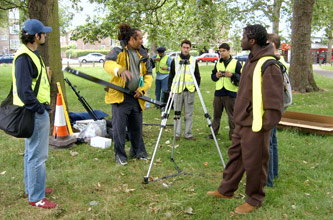 |
Sacha Bowling is showing the students how to set-up the CamCrane properly which can be a long and tiring process. Avoid working more than 12 hours a day and 6 days a week. An exhausted actor or crew can become demoralised and ineffective. Always cover travel expenses and feed the crew. This will avoid rebellion when you least need it. Treat everyone with fairness and honesty. Never lie about the money or the conditions. That way, no-one will ever have cause for complaint. (North Pole Road), Summer 2004 |
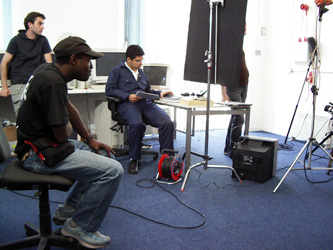 |
Wayne Harrison is the director and is watching the broadcast monitor to make sure that the shots look good when the actor is performing. Try to cover the scene and make sure you have enough shots that tell the story. Try to get as many cutaway shots as possible. Cutaway shots are scenes that "cut" away from the action. Crowds, cheering fans, cheerleaders and side-line action are all examples of cutaway shots. No editor can be better than the material he or she is given to work from. If the director has overlooked the necessity of a cutaway shot, or left insufficient overlap of action, the transitions do not flow easily and the editor's task is almost impossible! (Notting Dale Studios), Summer 2004 |
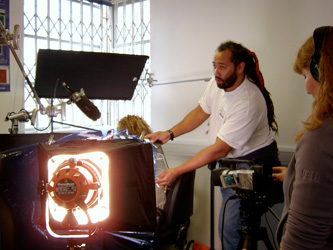 |
Sacha Bowling is doing the clapper board on a movie called "Chain Reaction" written by Jayne Norris. Make sure each shot has a board on it. When possible, do head slates, which are done at the beginning of the shot. Head slates speed the process of putting the sound and picture in sync in the telecine suite or editing room. Tail slates, done at the end of the shot, are often preferable for unstaged documentary filming or emotional acted scenes, since they are less disruptive and do not loudly announce to everyone that filming is about to begin. Clapperboards are usually held upside down to indicate a tail slate. (Notting Dale Technology Centre, Room 1), Spring 2004 |
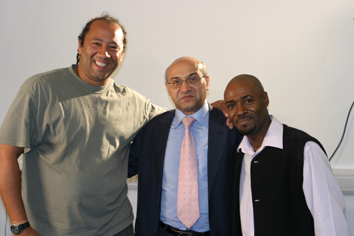 |
Sacha Bowling and Wayne Harrison are being congratulated by Hoss Malek (Managing Director) for their hard work on another successful Video Production Course, (Notting Dale Technology Centre, Room 1). Summer 2004. |